The Royal Easter Show Began As the Royal Agricultural Society of NSW
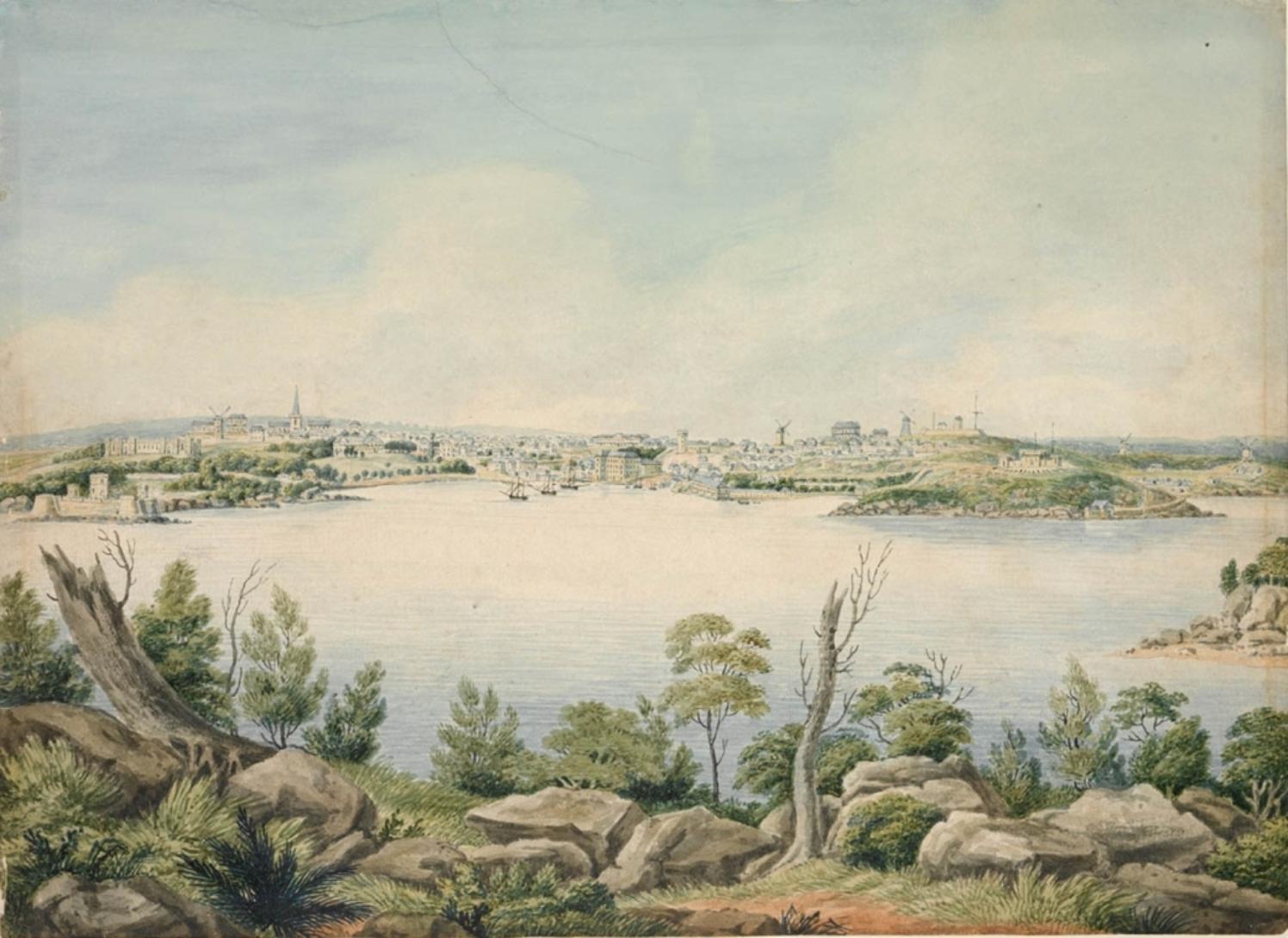
North View of Sydney New South Wales taken from the North Shore. 1822 by Joseph Lycett, ca. 1775-1828. Image No.: a928339, courtesy State Library of NSW
This is where what we call the Royal Easter Show really began as an idea conceived by our earliest farmers – the aim was, just a mere 34 years years after Europeans began settling here (1788), to “improve the quality of Australia's primary production by means of contests and competitions”.
There will be some who state the Royal Easter Show does not stem from these original 'shows' and everyone is entitled to think what they will. An article at the base of this page states any livestock 'shows' actually began a lot earlier in 1806. Our intention is merely to offer you an old fashioned 'pictorial' this week, reproduce these early articles so you may make up your own mind, and hopefully inspire you to wander through the Agricultural Pavilions or visit the main arena and wonder about the food on your plate and where it comes from.
What did they do? They held a meeting and made some decisions. If you read through the list of names of people at this first meeting you may recognize surnames and people now quite famous in our Australian history who have had whole districts and suburbs named for them:
1. Resolved,-That it is highly expedient for the best Interests of the Colony, that the present Meeting do form itself into a Society, to be denominated "The Agricultural Society of New South Wales"
2. That Sir JOHN JAMISON, Kt. & K. G. V. be appointed the President of this Society.
3. That the Honorable Mr. Justice FIELD, the Reverend Mr. MARSDEN, J. P. WILLIAM Cox, Esq. J. P. and Dr. TOWNSON, L. L. D. be appointed the Vice Presidents of this Society.
4. That G. T. PALMER, J. P. and ALEXANDER BERRY, Esquires, J. P. be the joint Secretaries of this Society.
5. That Messrs. RILEY and WALKER be the Treasurers of this Society.
6. That the following Gentlemen, jointly with the President and Vice-Presidents, be appointed the Committee, for conducting the Affairs of this Society, seven of whom shall form a Quorum :-
{ J. T. CAMPBELL, Esquire, J. P;
{JOHN PIPER, Esquire, J. P;
Sydney;
{EDWARD WOLLSTONECRAFT, Esquire, J. P;
{NICHOLAS BAYLY, Esquire.
{JOHN PALMER, Esquire, J. P;
{JOHN BLAXLAND, Esquire, JP;
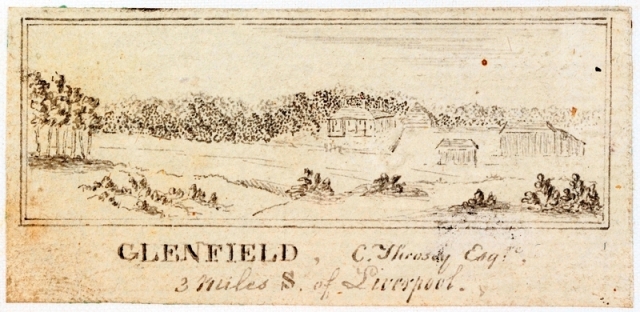 Parramatta;
Parramatta;{H. G. DOUGLASS, Esquire, J. P;
{Reverend T. HASSALL.
{WILLIAM HOWE, Esquire, J. P;
{ROBERT LOWE, Esquire, J. P ;
{JOHN OXLEY, Esquire, J. P ;
{CHARLES THROSBY, Esquire, J. P;
{THOMAS MOORE, Esquire, J. P;
{RICHARD BROOKS, Esquire, J. P ;
Airds;
{Captain BRABYN, J.P;
{ JOHN HARRIS, Esquire, J. P ;
Bringelly;
{ARCHIBALD BELL, Esquire, J. P
{H. C. ANTILL, Esquire, J. P ;
& Windsor;
{ JOHN McHENRY, Esquire, J. P ;
{WILLIAM LAWSON, Esquire, J. P;
{JOHN WOOD, Esquire;
{ANDREW ALLAN, Esquire ;
{JOHN HORSLEY, Esquire ;
{JOHN CAMPBELL, Esquire;
{GEORGE COX, Esquire.
Correspondent Members of Committee at Newcastle,
Reverend Mr. MIDDLETON;J. P. WEBBER, Esquire ; WILLIAM DUNN, Esquire; EDWARD CLOSE, Esquire.
Resolved,-That the President, Vice-presidents, and Secretaries, be requested to wait upon His EXCELLENCY the GOVERNOR, to solicit his Acceptance of the Office of Patron to this Society ; and to FREDERICK GOULBURN, Esquire, to accept the Vice Patronage thereof.
Resolved,-That the Committee do meet at the House of Charles Walker, at Parramatta, on Tuesday the 16th Instant, at Ten, A. M. for the Purpose of preparing a Series of Rules and Regulations for the Government of the Society.
Resolved,-That an Annual Subscription of Five Guineas be paid by each Member into the Hands of the Treasurers, for the general Purposes of the Association.
Resolved,-That many Members of the Society, having expressed their Intention of forming a Subscription Fund, in Shares of £25 each, for the Purpose of introducing from the Mother Country, and elsewhere, a more important Breed of Cattle, Horses, Sheep, &c ; that such other Members, as may desire to participate in the Advantages expected to accrue from those Importations, will communicate the same to the Secretaries at an early Day.
Resolved,-That it be particularly requested, that such Gentlemen as have been unable to attend the present Meeting, should they desire to become Members of the Society, will express their Intention, by Letter, to the Secretaries, or to the Committee at their next Meeting.
Resolved,-That the Proceedings of the present Meeting be inserted in the next, and three subsequent Sydney Gazettes.
The Thanks of the Meeting were unanimously voted to Sir John Jamison, for his Attention and Abilities as Chairman on this Occasion.
The Thanks of the Meeting were also unanimously voted to E. Wollstonecraft, Esq. for his able Assistance in forwarding the present Association.
JOHN JAMISON, President.
AGRICULTURAL SOCIETY OF NEW SOUTH WALES. (1822, August 2). The Sydney Gazette and New South Wales Advertiser (NSW : 1803 - 1842), p. 2. Retrieved from http://nla.gov.au/nla.news-article2181211
The second meeting, as given above, took place at Walker's Inn, Parramatta. The Society staged its first show in Parramatta in 1823.
AGRICULTURAL SOCIETY. THE AGRICULTURAL SOCIETY OF NEW SOUTH WALES hereby offer the following. PREMIUMS; to be adjudged at their Quarterly Meeting, in the first Thursday in October next; viz.
1. 2.-For the best Australian Merino two-toothed Rams and Ewes, not less than five of each description-A Piece of Plate, value 40 Dollars, for each description.
3.-For the best Australian Merino Ewe Limbs, not less than ten in number-A Piece of Plate, value40 Dollars.
4, 5.-For the second best Australian Merino two toothed Rams and Ewes, not less than five of each description-A Piece of Plate, value 20 dollars, for each description.
6.-For the second best Australian Merino Lambs, not less than ten in number-A Piece of Plate, value 50 Dollars.
7. 8.-For the third best Australian Merino two toothed Rams and Ewes, not less than five of each description-A Piece of Plate, value 12 Dollars, for each description.
9. For the third best Australian Merino Ewe Lambs, not less than ten in number- A piece of Plate, value 12 Dollars.
10.,-For the best Colonial-bred Bull, not more than three years old-A Piece of Plate, value 40 Dollars.11.-For the second best Colonial-bred Bull, not more than three years old-A Piece of Plate, value 20
Dollars.
12.-Tor the best two-year old Heifer, Colonial-bred- A Piece of Plate, value 20 Dollars. 13.-For the best Colonial-bred Stallion, not exceeding three years old-A Piece of Plate, value 16 Dollars.
SERVANTS.
1.-To the Shepherd, who produces from his Master a Certificate, on Oath before a Magistrate, of his having "weaned the greatest Number of Lambs, in Proportion to the Number of Ewes in his Charge, for the Year, not having less than 300 Ewes in his- Flock-A Premium of 32 Dollars.
2.-To the Shepherd, who produces a like Certificate, of having weaned the next greatest Number of Lambs-A Premium of 16 Dollars.
3.-To the Man-Servant, employed in Husbandry or , Grazing, or the Management of the Dairy, who brings satisfactory Certificates of good Conduct during his Servitude, and has been the-longest Period in one Service-not less than seven years A Premium of 20 Dollars.
4.-To the Man-Servant, employed as above, who may produce the second best Certificate to the same Effect-A Premium of 12 Dollars.
5.-To the Man-Servant, employed as above, who who may produce the third best Certificate to the same Effect-A Premium of 8 Dollars.
Parramatta, April 11, 1823.
G. T. PALMER }secretaries
ALEX. BERRY, }
Classified Advertising. (1823, April 24). The Sydney Gazette and New South Wales Advertiser (NSW : 1803 - 1842), p. 4. Retrieved from http://nla.gov.au/nla.news-article2181822
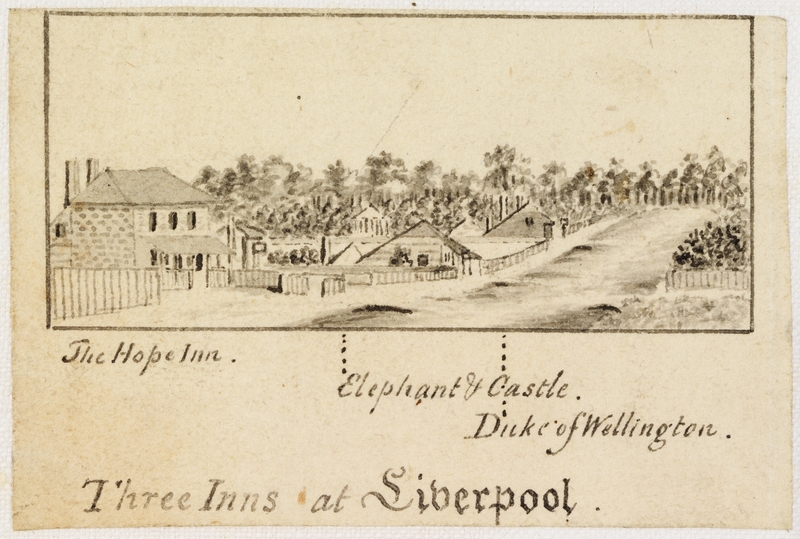
The half-yearly Fair at Parramatta, on Thursday last, was well attended with visitors. The show of cattle was far inferior to former season, but there were some good woolled rams, as well as other stock. There were very few buyers.
On Thursday last, a very numerous Meeting of the Agricultural Society assembled at Parramatta. It being the day of the public fair, the Society's prize cattle and sheep were exhibited, and the premiums adjudged. So many meritorious horses were shewn, that a second prize was voted. The first was awarded to Mr. Samuel Terry (though not a Member of the Society), and the second to Captain Piper, for their respective three-year old stallions; but Mr. H. McArthur's two-year old colt Canon, seemed to he the public favorite. They were all three got by Model, and the two prize horses were bred by the late Mr. Bayly. Mr. H. McArthur obtained the prize for the best rams; Mr. Howe for the best ewes; and Mr. Oxley for the best lambs. The judges of the stock were, Mr. Cox, Mr. J. Campbell, and Mr.
G. T. Palmer.
The servants' rewards were adjudged as follow:— To Maurice Roche, shepherd to Mr. Oxley, for having weaned 297 lambs from a flock of 316 ewes—thirty two dollars. To Henry Ashford, shepherd to Rev. S. Marsden, for good conduct during a service of 16 years— twenty dollars. To William Bull, servant to James Davison, for good conduct, during a service of 11 years— twelve dollars. And to Walter McTaggart, servant to Hugh Kelly, for good conduct during a service of 8 years—eight dollars. The men were called before the
Meeting, and immediately presented with the money by the President.
In short, in the present depressed state of agriculture, the public spirit for breeding and grazing appeared this day to be practically influenced by the encouragement and example of the Agricultural Society.
At this Meeting, Mr. Wollstonecraft presented the Society with a Model, and read an explanation, of General Beatson's Cultivator; and the Building Committee laid before them a very pretty plan and elevation of the Society's intended house in Parramatta. His EXCELLENCY the PATRON communicated a handsome letter from Lord Bathurst, in answer to the Society's Petition for the Repeal of the Wool-duty. This Body now consists of 112 Members; and 11 new names were this day proposed.—Five and forty Gentlemen sat down in the evening to dinner at Walker's Inn; after which, among other loyal and appropriate toasts, the health of Mr. Buxton, who has accepted the office of Parliamentary Protector of the Society, was drank with 3-times-3.Captain Piper kindly brought his Band, and the night was spent in social harmony. Thus concluded perhaps the most useful and interesting Meeting the Society has yet held. MAGISTRATE FOR THE ENSUING WEEK, ALEXANDER BERRY, ESQUIRE. (1823, October 9). The Sydney Gazette and New South Wales Advertiser (NSW : 1803 - 1842), p. 2. Retrieved from http://nla.gov.au/nla.news-article2182286
Despite its initial success the Society was forced to disband in 1836 due to poor economic conditions and lack of support. In 1857 it reformed. From 1868, the Journal of the Agricultural Society of NSW was published, the first of its kind in Australia, containing practical information and latest agricultural developments for those on the land.
The annual Shows moved from Parramatta to Sydney’s Prince Alfred Park after 1868, and then to a new site at Moore Park in 1882. Little more than scrubland at the time, it was here that the Society built a showground which would be home to the Show for the next 116 years. The 1919 Bubonic Plague and World War II prevented the Show going ahead during those times - the showgrounds actually being put to use for war work during WWII. The Society was renamed the ‘Royal’ Agricultural Society of NSW in 1891, by special permission of Queen Victoria, and the first 'Royal' Easter Show was held the same year.
The Show’s competitive displays showcased the best animals and rural produce – from prize-winning cattle, sheep and pigs to fruit and vegetables exhibits, as well as displays of wood chopping, show jumping, and even ploughing demonstrations, as they do today. These annual 'shows' were also an opportunity for the exchange of ideas and practices, an opportunity for farmers to gain first-hand knowledge of farming trends and technological advances.
By the mid 1930s, as the grip of the Depression in Australia began to lift, the Show’s attendance figures increased and there was a growing optimism in Australia’s agricultural future. The 1935 Royal Easter Show was the biggest to date, with the largest attendances, prize-money and competitive entries.
You may access more about the Royal Easter Show and it’s early years in an online exhibition the State Library of NSW has at: www.sl.nsw.gov.au/discover_collections/history_nation/agriculture/communities/royal_agricultural_society/.
Perhaps seeing these images will encourage you to explore the great online images available at our State Library if you get a rainy day these holidays and see not only beautiful and interesting pictures and photos but find out a bit more about them and your own history.
Photography of course did not exist then, although people were trying out the techniques as early as 1800. People of these times made sketches and drawings and did landscape paintings, portraits were painted of people, not photographs taken. One of the early sketchers of farms and homes in New South Wales was Edward Mason and the sketches, some of which are shared below, are attributed to him and come from NSW State Library albums titled “Views of Sydney and Surrounding District” ca. 1821-1823; 1892. The coloured paintings are from Collection of views predominantly of Sydney, Liverpool, and the Sunda Straits, and portraits, ca 1807, 1829-1847, 1887] / owned by A.W.F. Fuller and the ones we've chosen are by Joseph Lycett.
It is from these collections that we can see what the farms and lands around the above mentioned gentlemen were like. You will see at the bottom of some sketches ‘so many miles from’ – this means so many miles from Sydney.
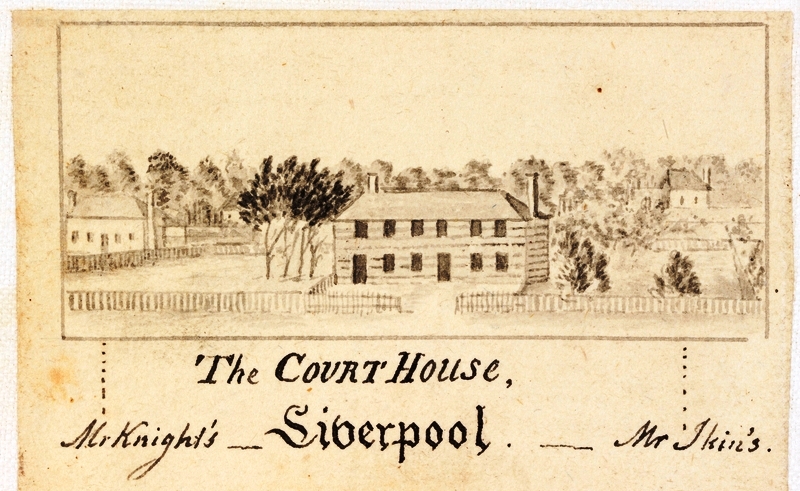
The State Library of NSW has a great source of online materials you may access so you can see a wealth of all things Australian. The National Library of Australia also stores many images and texts you may access online. We found a few there too.
The Biographies included as smaller extracts stem mostly from another great online resource The Australian Dictionary of Biography, although some researchers, and even members of the families whose relatives are listed, have told us there are inaccuracies in these texts, possibly due to literature that was not available when they were originally created. This great resource may be accessed at: http://adb.anu.edu.au/ and will be invaluable should you want to investigate those we haven't listed something about on this page.
We hope sharing a little of these images and some information about a few of these initiators of what we now call the Royal Easter Show will inspire you to have a look at the Agriculture Displays should you go to the show this year and wonder about more about where your milk, eggs, fruit and vegetables all come from.
In what is said about these early promoters of agricultural industry in New South Wales it is important to remember when reading about their lives that some came from padded salons and green fields to what, to them, was a virtual wilderness with no roads and they had little or no knowledge of the abundance of foods already here while others were simply determined to make better opportunities for themselves. They all had a willingness to undertake a big adventure.
When you look at these images and read about these people bear in mind that they had to grow the wheat, then mill it, then make bread. If they wanted to spread some butter on their slice, they had to buy and house and feed a cow - then milk it, then churn it into butter. Jam for your bread? - plant the fruit, tend it so it grows, pick it in season and turn it into jam - now you may have a jam sandwich!
Of the purported sketcher, Edward Mason, there is little recorded. It is now thought (2006) the drawings are not copies and possibly(?) the work of Edward Mason, clerk to magistrates, Liverpool; merchant and landholder. Reference: Colonial Secretary Index, 1788-1825, State Records NSW, although some sources state the Edward Mason who compiled these sketches did not come to Australia until 1853 and these must be copies of earlier drawings.
What we could find around the same time of a gentleman of the same name (investigations can often bring up as many questions as answers!):
THE LATE MR. EDWARD MASON. GENTLEMAN.
(FROM A CORRESPONDENT.)
Such a misrepresentation of the circumstances relative to the premature death of the late unfortunate Gentleman, Mr. EDWARD MASON, as might tend to darken his urn, has appeared in one of the public Newspapers. As an intimate acquaintance of the deceased, from the period of his first arriving in the Colony, I should not do justice either to his memory, or the family to which he was allied, were I not to confer this small tribute on his high talents and acquirements; which, though long shaded, and almost obscured, are now set in oblivion. He was interred yesterday, the 14th, from this lodgings, in Hunter-street, Sydney.
Mr. Mason had attained the climacteric of human life, being about 56. He descended from a family of high respectability, now in England. His classical and accomplished education was well displayed in that prodigy of genius he possessed, and he had, for a series of years, formed a close intimacy with characters of the first literary fame in England; but the accession of less favorable vicissitude, to which human nature is ever liable, doubtless operated so power-fully and variously on his mind, during his latter years, as ultimately to extinguish the radiance of his evening sun; yet, to the last few days, those who had the pleasure of access to him, with refined corresponding views, the intervals were such as will tender his loss to be, to them, a source of lasting regret. To such only were his qualifications and his virtues known; and though, at the last, none were ready by him, to " Wipe the cold dew, or stay the sinking head-' to avert the shaft of reproach on his memory-“ "Let him that is without a fault cast the first stone.” Sydney, 15th Sept. 1828. UMBROSUS. THE LATE MR. EDWARD MASON[?] GENT[?]. (1828, September 17). The Sydney Gazette and New South Wales Advertiser (NSW : 1803 - 1842), p. 2. Retrieved from http://nla.gov.au/nla.news-article2191060
From State Records of New South Wales - Colonial Secretary Index, 1788-1825 - Liverpool, Magistrates (Apr 1822) to Lloyd, B:
1822 Apr 15 Edward Mason wanting to know "how far the Governor's Order 'recalling the servants allowed to overseer with a substitution of salary'" applied to his situation (Reel 6054; 4/1757 p.152)
Of the artist Joseph Lycett there is a little more. You can read about him in The Lycett Album - National Library of Australia 1990 HERE (PDF 5.5MB) or this extract from Wikipedia states his was transported for forgery and spent only seven years in the colony:
Joseph Lycett (c.1774 – c.1825) was a portrait and miniature painter, active in Australia. He specialised in topographical views of the major towns of Australia, and some of its more dramatic landscapes. He was convicted of forgery on 10 August 1811 and was transported to Australia, sailing aboard the General Hewitt, arriving in 1814. In May 1815 while Lycett was employed in the police office, Sydney was flooded by hundreds of skillfully forged 5 shilling bills drawn on the postmaster. They were traced to Lycett, who was found in possession of a small copper-plate press. Lycett was sent to Newcastle, where he came to the attention of the commandant of the settlement, Captain James Wallis. There Joseph drew up the plans for a church which Wallis projected and, when it was built in 1818, he painted the altar piece and is said to have also produced the three-light window which still survives in the bishop's vestry of Newcastle Cathedral. On the recommendation of Captain Wallis, Lycett was given a conditional pardon. He returned to Sydney and was allowed to practice his art, and in 1820 Governor Macquarie sent three of his paintings including a large view of Sydney to Earl Bathurst. It is generally believed that the absolute pardon which the Lycett received on 28 November 1821 was a reward for these. Many of his patrons seem to have been drawn from the military and public service elite, and included Commissioner John Thomas Bigge (who described Lycett's 'habits of intoxication' were 'fixed and incurable'), his secretary Thomas Hobbes Scott, and Macquarie's aide-de-camp John Watts. Lycett had possibly married in the colony, for in June 1822 he advertised that he intended to leave accompanied by his two daughters. They sailed together in the Shipley in September. Although his later publication Views in Australia suggests Lycett also visited Tasmania, there is no evidence of his actually travelling there.
He returned to England in September 1822, having been granted an absolute pardon. With publisher John Souter, between July 1824 and June 1825 he issued Views in Australia, or New South Wales and Van Diemens Land in 12 parts published monthly, each with two aquatint views of New South Wales and two of Van Diemen's Land, with descriptive letterpress, and a supplement with maps of both colonies. By permission the series was dedicated to Bathurst. The parts began to appear in July 1824 at 7s. plain and 10s. 6d. coloured. With its complicated publishing history, the extent of Lycett's involvement in the entire production is unclear, and it does seem that the book was not successful. These views were reissued in a volume in 1825. The 50 plates are coloured in some copies and plain in others. Joseph Lycett. (2014, March 18). In Wikipedia, The Free Encyclopedia.
You can see more of his works in both the State Library of NSW and the National Library of Australia online resources.
And before the glorious pictures, the piece we found that points to 1806 as the first 'show' of an agricultural kind:
Royal Agricultural Society of N.S.W. FIRST SHOW HELD IN 1806 (By Frank McCaffrey.)
To get to the beginning of our agricultural shows in New South Wales we have to go back to 1806 when the first cattle show was held at Parrarnatta on Sunday, 13th July of that year. Those present included Governor King, Major George Johnston, Rev. Samuel Marsden, together with the owners of 3000 head of cattle. As this show was not held under strict Sabbatarian rules a little trading in flock was indulged in, but to display their charitable hearts a present of seventeen cows was given to the Female Orphan Institution of Parrarnatta. This institution, according to Major Moodie, gave us the mothers of many of the leading families of Australia. (Mr. Moodie's book is in. the Mitchell Library. F.McC.)
Those meetings were generally termed "mustres," and doubtless led to the formation of the Royal Agricultural Society of N.S.W. in 1821, of which we have read much in the press during the early part of the year 1822, owing to the great effort put forth to prove that the present R.A.S. is a continuation of the show established in Parrarnatta in 1821.
If the present R.A. Society can be connected in a continuous line from the year 1855 I do think it is as far back as it can be honestly traced. A move was made to establish the metropolitan show in Prince Alfred Park in 1868, and a show on a large scale was held there in 1870, and a few years later it was established in Moore Park. The title of Royal A.S. came into use in 1891.
When I began to compile the "First Century a Dairying in N.S.W.," which was published in 1906, a friend of mine sent me a sheet of paper, the writing on which was, my friend said, "that of the late Mr. Alexander Berry, M.L.C." It contained a list of subscribers to a stock fund to import stock for stud purposes from England. The following is a list of the subscribers to the stock fund-1823: -
James Atkinson. Esq £25 Alexander Berry. Esq 50 John Blaxland. Esq 25 Richard Brooks, Esq 25 John T. Campbell, Esq 25James Chandler, Esq 50William Cox. Senr., Esq 25 William Cox. junr.. Esq 25 Robert Crawford. Esq .. 25 Prosper de Mestre, Esq 25 John Dixon, Esq 25 Major Goulburn ..100 William Howe, Esq 25 Sir John Jamison ....100 Captain King, R.N 25 William Lawson, Esq 25 Robert Lowe. Esq 25 Hannibal Macarthur, Esq. .... 25Thomas McVitie. Esq 25 Rev. Samuel Marsden ... 25 William H. Morris, Esq. -.... 25 James Norton, Esq 25 Nathaniel Norton, Esq 25 John Oxley, Esq. 25 John Palmer, Esq 25 George T. Palmer, Esq 25 John Piper, Esq 25 Edward Riley, Esq 25 Charles Throsby, Esq 25 Dr. Robert Townson, LL.D. .... 25 William Walker, Esq. .. ..... 50 Thomas Walker, Esq. 25D'Arcy Wentworth, Esq 25Major West : - 25Edward Wolstoncraft, Esq. ... 50
Allan Cunningham, Esq., Corresponding Secretary. Royal Agricultural Society of N.S.W. (1926, March 26). The Land(Sydney, NSW : 1911 - 1954), p. 2 Supplement: Supplement to "THE LAND.". Retrieved from http://nla.gov.au/nla.news-article116262665
* The Agricultural Society of NSW did hold a 3 day show, with prizes, at Prince Alfred Park as part of the Inter-Colonial Exhibition in 1869 - another instance of many minds making up their ways differently or these gentlemen being unable to access reports that detail these events when this article was first written:
AGRICULTURAL SOCIETY'S PRIZE FOR CHEAP SUGAR MACHINERY. SIR,-You have doubtless ere this examined the Schedule of Prizes advertised by the Agricultural Society of New South Wales, for competition at the Intercolonial Exhibition to take place in Prince Alfred Park, Sydney, on 31st March and two following two days... I. am, Sir, Yours, &c., O. O. DANGAR, Kempsey, November 10th. AGRICULTURAL SOCIETY'S PRIZE FOR CHEAP SUGAR MACHINERY. (1868, December 1). Clarence and Richmond Examiner and New England Advertiser (Grafton, NSW : 1859 - 1889), p. 4. Retrieved from http://nla.gov.au/nla.news-article61889671
It was moved and carried,-"That the schedule of prizes for the Metropolitan Intercolonial Exhibition, to be held in the Prince Alfred Park, Sydney, on the 31st of March, 1st and 2nd of April, 1869, now read, be adopted.-1st, wool: live stock-2nd, cattle; 3rd, horses ; 4th, sheep; 5th, pigs; 6th, poultry ; 7th, dogs : 8th, wine ; 9th, farm produce; 10th, fruits, vegetables, and flowers ; 11th, manures ; 12th, sugars; 13th, agricultural implements ; 14th, manufactured articles; 15th, works of art; 16th, field trials of agricultural implements. AGRICULTURAL SOCIETY OF NEW SOUTH WALES. (1868, October 9). The Sydney Morning Herald (NSW : 1842 - 1954), p. 2. Retrieved from http://nla.gov.au/nla.news-article13173949
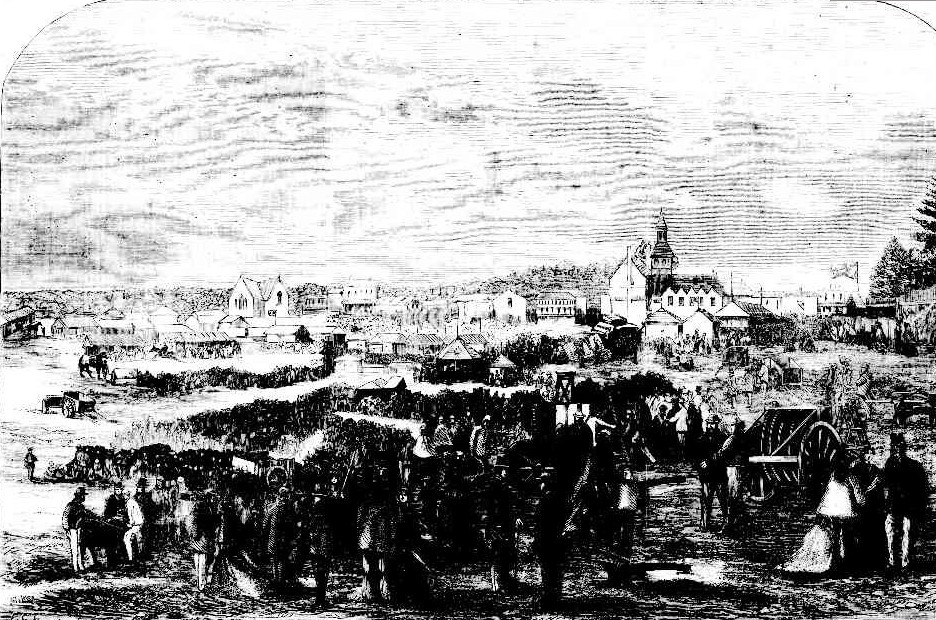
VIEW OF THE METROPOLITAN INTERCOLONIAL EXHIBITION HELD IN PRINCE ALFRED PARK, SYDNEY, OPENED ON MAY 4TH. (1869, May 13). Illustrated Sydney News (NSW : 1853 - 1872), p. 13. Retrieved from http://nla.gov.au/nla.news-article63514513
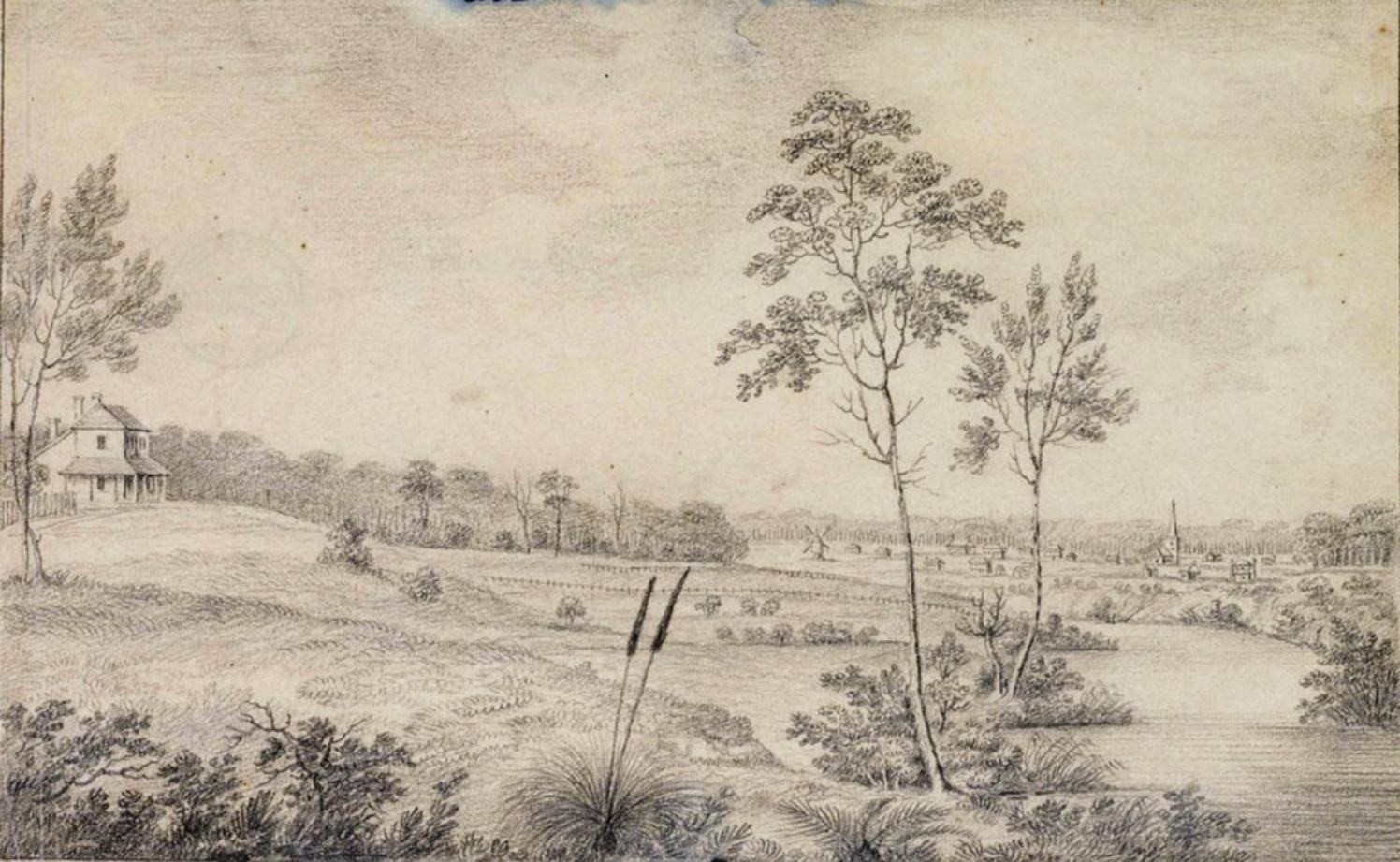
Moorebank, near Liverpool - The Residence of Thos. Moore Esq. Image No.: a1120006, courtesy State Library of NSW.
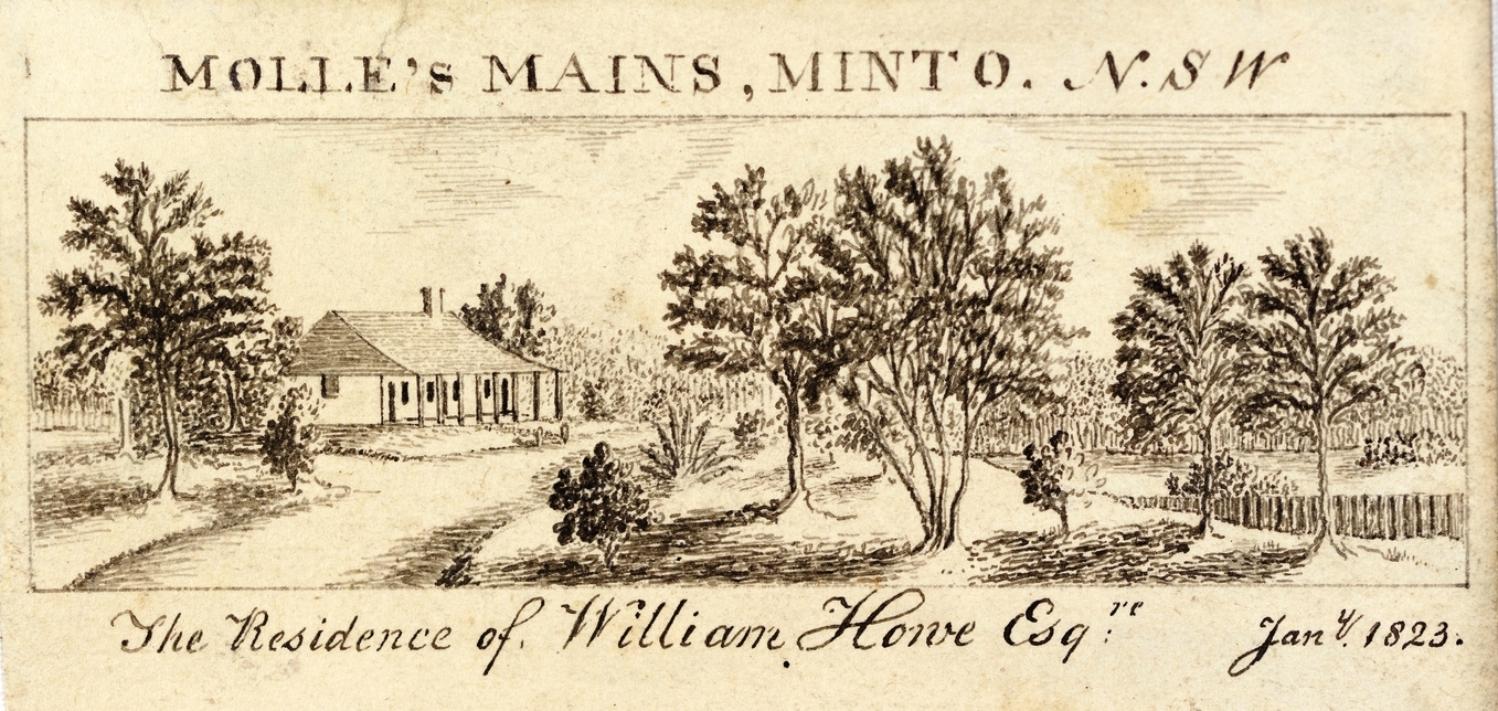
Molle's Mains from the N.E. - Views of Sydney and Surrounding District by Edward Mason, Image No.: a1080009, courtesy State Library of NSW
Sir JOHN JAMISON
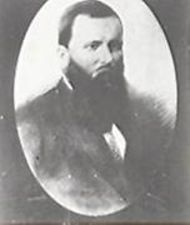 Sir John Jamison (1776 – 29 June 1844) was an Australian physician, pastoralist, banker, politician, constitutional reformer and public figure. He was the son of Thomas Jamison (1752/53-1811) and Rebecca (1746-1838). Thomas Jamison was a Northern Irishman, who arrived in New South Wales, Australia, with the First Fleet in 1788, aboard HMS Sirius, as a surgeon's mate. Soon afterwards, Thomas was sent to the auxiliary British colony of Norfolk Island, where he served as principal medical officer during the 1790s - while accumulating wealth on the side as a maritime trader. Then, in 1801, after taking leave in England, Thomas was promoted to the position of Surgeon-General of New South Wales due to his intelligence, administrative competence, driving ambition and gift for cultivating useful patrons in London. While serving with the Royal Navy's Baltic Fleet in 1807 - aboard the hospital ship Gorgon - he was successful in treating an outbreak of scurvy in the allied Swedish Navy, and was made a knight of the Order of Vasa by a grateful Swedish king. He was also knighted by Britain's Prince Regent (afterwards King George IV) in May 1813, and subsequently appointed Inspector of Naval Hospitals and Fleets.
Sir John Jamison (1776 – 29 June 1844) was an Australian physician, pastoralist, banker, politician, constitutional reformer and public figure. He was the son of Thomas Jamison (1752/53-1811) and Rebecca (1746-1838). Thomas Jamison was a Northern Irishman, who arrived in New South Wales, Australia, with the First Fleet in 1788, aboard HMS Sirius, as a surgeon's mate. Soon afterwards, Thomas was sent to the auxiliary British colony of Norfolk Island, where he served as principal medical officer during the 1790s - while accumulating wealth on the side as a maritime trader. Then, in 1801, after taking leave in England, Thomas was promoted to the position of Surgeon-General of New South Wales due to his intelligence, administrative competence, driving ambition and gift for cultivating useful patrons in London. While serving with the Royal Navy's Baltic Fleet in 1807 - aboard the hospital ship Gorgon - he was successful in treating an outbreak of scurvy in the allied Swedish Navy, and was made a knight of the Order of Vasa by a grateful Swedish king. He was also knighted by Britain's Prince Regent (afterwards King George IV) in May 1813, and subsequently appointed Inspector of Naval Hospitals and Fleets.
Meanwhile, Thomas Jamison had died in London in 1811. Jamison succeeded to his father's property, which included land at Jamisontown on the Nepean River, west of Sydney. He arrived in Sydney on 28 July 1814, aboard the Broxbornebury, to take up his patrimony. The following year, he accompanied Governor Lachlan Macquarie on his official visitation to the Bathurst Plains, and had the Jamison Valley in the Blue Mountains named in his honour by Macquarie. But two and a half years later, he fell out of favour with the governor, who described him in a private dispatch as being "intriguing and discontented".
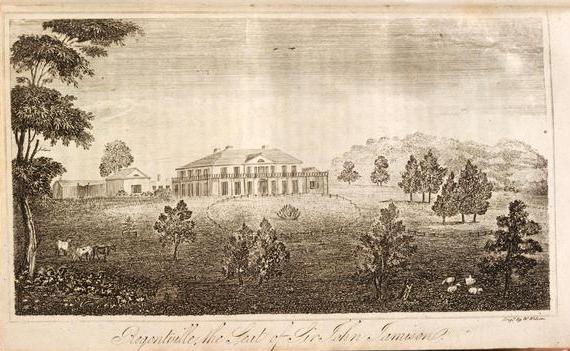 Jamison was Australia's first titled free settler and thus head of the fledgling country's social pecking order. He acquired allotments in the heart of Sydney, and accumulated vast tracts of land in the central-western and northern parts of New South Wales between 1814 and 1840. He was a founder of the Bank of New South Wales in 1817, and established himself as one of the most prominent (and wealthiest) men in Australia, enjoying a reputation for lavish entertaining and hospitality at Regentville, his magnificent rural estate near the town of Penrith.
Jamison was Australia's first titled free settler and thus head of the fledgling country's social pecking order. He acquired allotments in the heart of Sydney, and accumulated vast tracts of land in the central-western and northern parts of New South Wales between 1814 and 1840. He was a founder of the Bank of New South Wales in 1817, and established himself as one of the most prominent (and wealthiest) men in Australia, enjoying a reputation for lavish entertaining and hospitality at Regentville, his magnificent rural estate near the town of Penrith.
Governor Darling in 1829 mentioned that Jamison was then President of the New South Wales Agricultural Society, "holding perhaps the largest stake in the country". In 1830, London's Society for the Encouragement of Arts, Manufactures and Commerce awarded him the large gold medal "for his successful method of extirpating the stumps of trees". He also won various awards for his wine and other agricultural produce and took a keen, scientific interest in the natural history of the Sydney region. He was a committed Freemason and a founding father of the New South Wales thoroughbred racing industry. Benevolent organisations benefited from his generosity, and in 1830 he helped establish Sydney College - an important educational facility which gave rise to both Sydney Grammar School and the University of Sydney. During the mid-1830s, he held office as founder-president of the Australian Patriotic Association, which strove to liberalise the colony's political and legal institutions as Sydney evolved from a penal settlement into a thriving, mercantile port.
Jamison High School at Penrith was named after Sir John Jamison
John Jamison. (2013, November 8). In Wikipedia, The Free Encyclopedia.
Picture: Regentville, the seat of Sir John Jamison [picture] [Sydney : J. Maclehose, 1838] nla.pic-an8421815 courtesy National Library of Australia
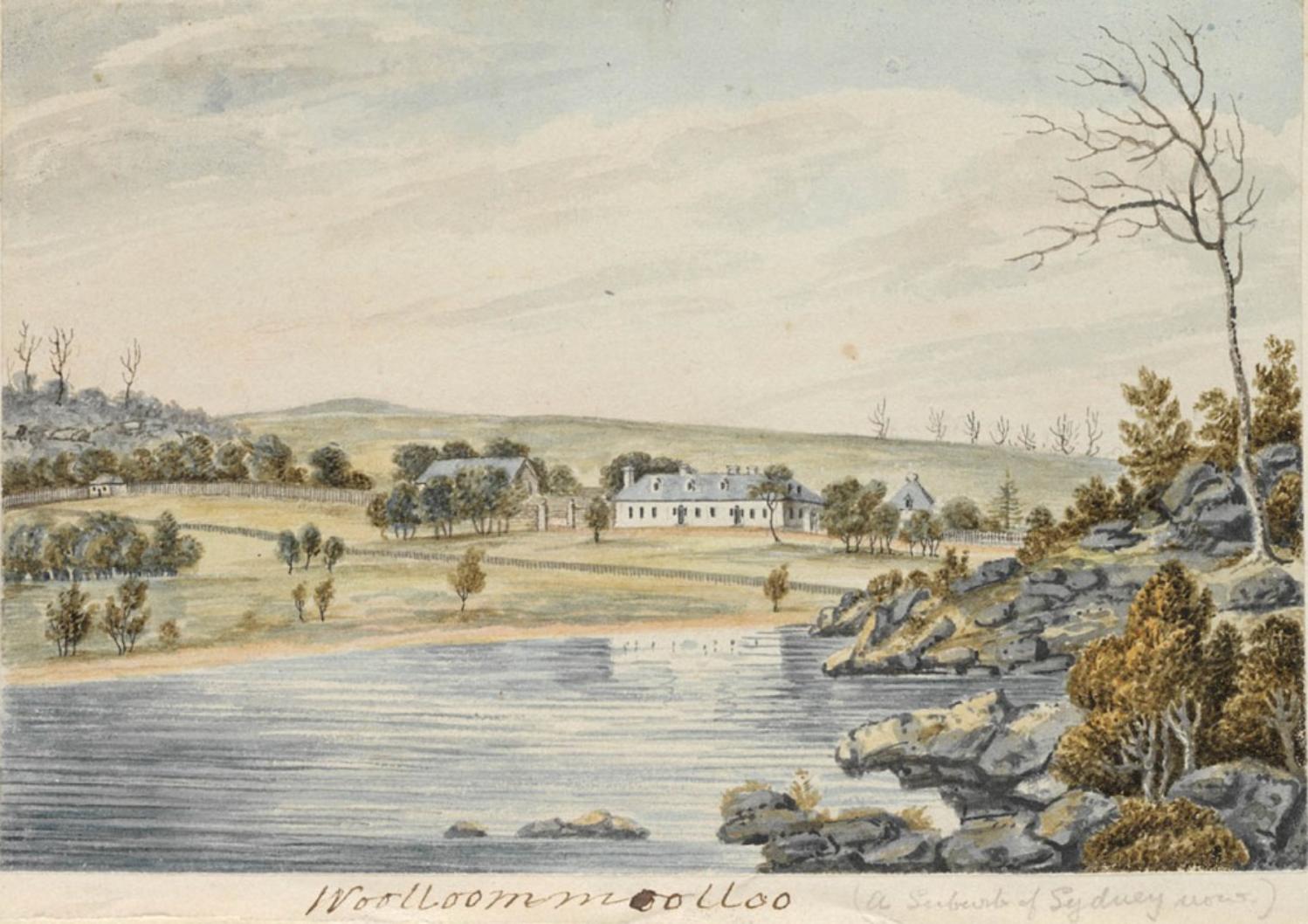
East View of Wooloomooloo near Sydney, Iamge No.: a1120003, courtesy State Library of NSW
JOHN PALMER, Esquire
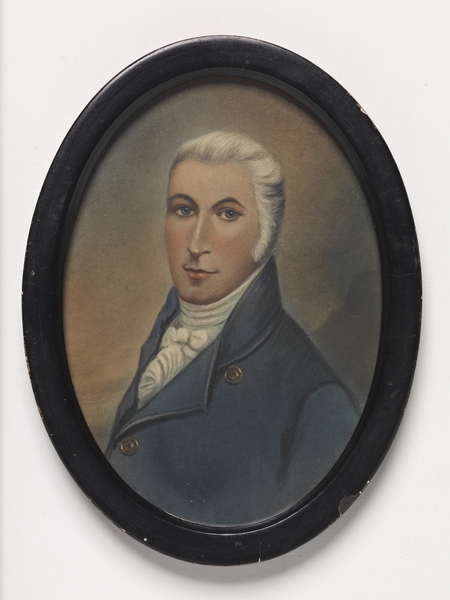 John Palmer (1760-1833), commissary, was born in England. He entered the navy as a captain's servant at 9, and appears to have been educated entirely in the navy, which maintained schoolmasters for such recruits. During the American war of independence he was serving in H.M.S. Richmond which was captured off Chesapeake Bay by a French squadron on 11 September 1781. In 1783, after his release as a prisoner of war, the dark, handsome officer married Susan Stilwell (1761-1832), daughter of an American loyalist family.
John Palmer (1760-1833), commissary, was born in England. He entered the navy as a captain's servant at 9, and appears to have been educated entirely in the navy, which maintained schoolmasters for such recruits. During the American war of independence he was serving in H.M.S. Richmond which was captured off Chesapeake Bay by a French squadron on 11 September 1781. In 1783, after his release as a prisoner of war, the dark, handsome officer married Susan Stilwell (1761-1832), daughter of an American loyalist family.
Palmer arrived in New South Wales with the First Fleet in 1788 as purser of Governor Arthur Phillip's flagship Sirius. The first Commissary, Andrew Miller, resigned in 1790 on account of ill health, and when the Sirius was wrecked off Norfolk Island Palmer was appointed commissary on 2 June 1791. In this post he was responsible for the reception and issue of all government stores, virtually the only supplies in the colony, and their supplement by purchase from private merchants. He negotiated payment for official business and was empowered to draw bills on the British Treasury. In effect he kept the public accounts and funds of the colony and was at once official supplier, contractor and banker to the settlement.
By 1793 Palmer had decided to settle in New South Wales, though he had to wait three years before his application for leave was granted. In September 1796 he left for England in the Britannia, returning in November 1800 in the Porpoise with his wife and children, two sisters, Sophia (1777-1833) and Sarah (b.1774), and a naval brother, Christopher (1767-1821). In February 1793 Lieutenant-Governor Francis Grose had granted Palmer 100 acres (40 ha) at the head of Garden Island Cove, then known as Palmer's Cove. Here, set in an extensive orchard, Palmer built Woolloomooloo Farm, one of the colony's first permanent residences, where the Palmers lived and elegantly entertained the first rank of colonial society.
'Little Jack' Palmer was one of the most enterprising of the early settlers and acquired much knowledge of all aspects of the colony through his private speculations. Active and adventurous, he had early explored the interior of the colony, most of which he believed capable of cultivation. In 1795 Captain Henry Waterhouse described him as one of the three principal farmers and stockholders in the colony and in 1803 Palmer was hailed as the first exponent of improved farming methods when he reduced the men employed on his 300-acre (121 ha) Hawkesbury farm from a hundred to fifteen. When giving evidence before the select committee on transportation in 1812 Palmer claimed, 'I had more ground than anybody else; I farmed more than any other person did'.
By 1803 he owned several small colonial-built craft. Two, the George and the John, were employed sealing in Bass Strait and another, the Edwin, plied up the Hawkesbury River and along the coast with grain, timber and coals. In 1803 one of his employees discovered a new coal-mine at Hunter's River.
On 17 September 1801 Palmer's sister Sophia had married Robert Campbell, and during Campbell's absence in England in 1805 and 1806 Palmer acted as his agent. Palmer also owned a windmill on the margin of the Domain and a bakery near the present Conservatorium of Music. It is claimed that during the disastrous floods of 1806, when scarcity of grain inflated flour prices, Palmer ordered bread to be sold to the needy at lower prices than were then common.
.jpg?timestamp=1395970083371)
Wooloomoolloo, [i.e. Woolloomooloo] / with the buying place of the "Palmers". Image No: 1080065h, courtesy State Library of NSW
The estate of Woolloomooloo, mortgaged for over £13,000, was eventually sold to Edward Riley for £2290 in May 1822, though the stock and furnishings were auctioned in 1816. In January 1818 Palmer was granted 1500 acres (607 ha) at Bathurst, which he named Hambledon, but he ran only a handful of stock. In the 1820s the family fortunes recovered. Palmer received a grant in the Limestone Plains known as Jerrabombera, while at Waddon, near Parramatta, he farmed 3000 acres (1214 ha), one-third of which was cleared. By the 1830s he was running more than 3000 sheep and nearly 500 cattle. From August 1803 to January 1824 he had been a member of the committee of the Female Orphan Institution. As a magistrate he sat frequently on the bench at Parramatta until dismissed by Governor Sir Thomas Brisbane in the quarrel over the case of Henry Grattan Douglass in 1822; he was restored to the magistracy on 3 November 1825 and continued to sit until within a year or two of his death. His reputation for discreet benevolence was enhanced by a friendly manner and cheerful nature. He was an adherent of the Church of England. When he died at Waddon on 27 September 1833, he was 'the last surviving officer of the first fleet that arrived in this part of His Majesty's Dominions'. His wife died in September 1832; she was survived by three sons, George Thomas, John (1797-1839) and Edwin Campbell (b.1802), and a daughter, Sophia Susannah (b.1803), who had married Edward Close.
Margaret Steven, 'Palmer, John (1760–1833)', Australian Dictionary of Biography, National Centre of Biography, Australian National University, http://adb.anu.edu.au/biography/palmer-john-2533/text3437, published in hardcopy 1967
John Palmer, R.N. – portrait - Presented by Mrs. J.C. Close, April 1966 - A label pasted onto the back of frame reads, "Copy of portrait of:- / John Palmer, R.N. / (Purser of H.M.S. "Sirius" / with the "First Fleet"; / and afterwards. / Principal Comissary / of the Colony of N.S. Wales; / finally / Assist.-Commissary-General of N.S.W.) / Relationship to Edward C. Close (Senr.) / Father-in-law". This image is thought to be based on a locket miniature. Image No.: a5460001
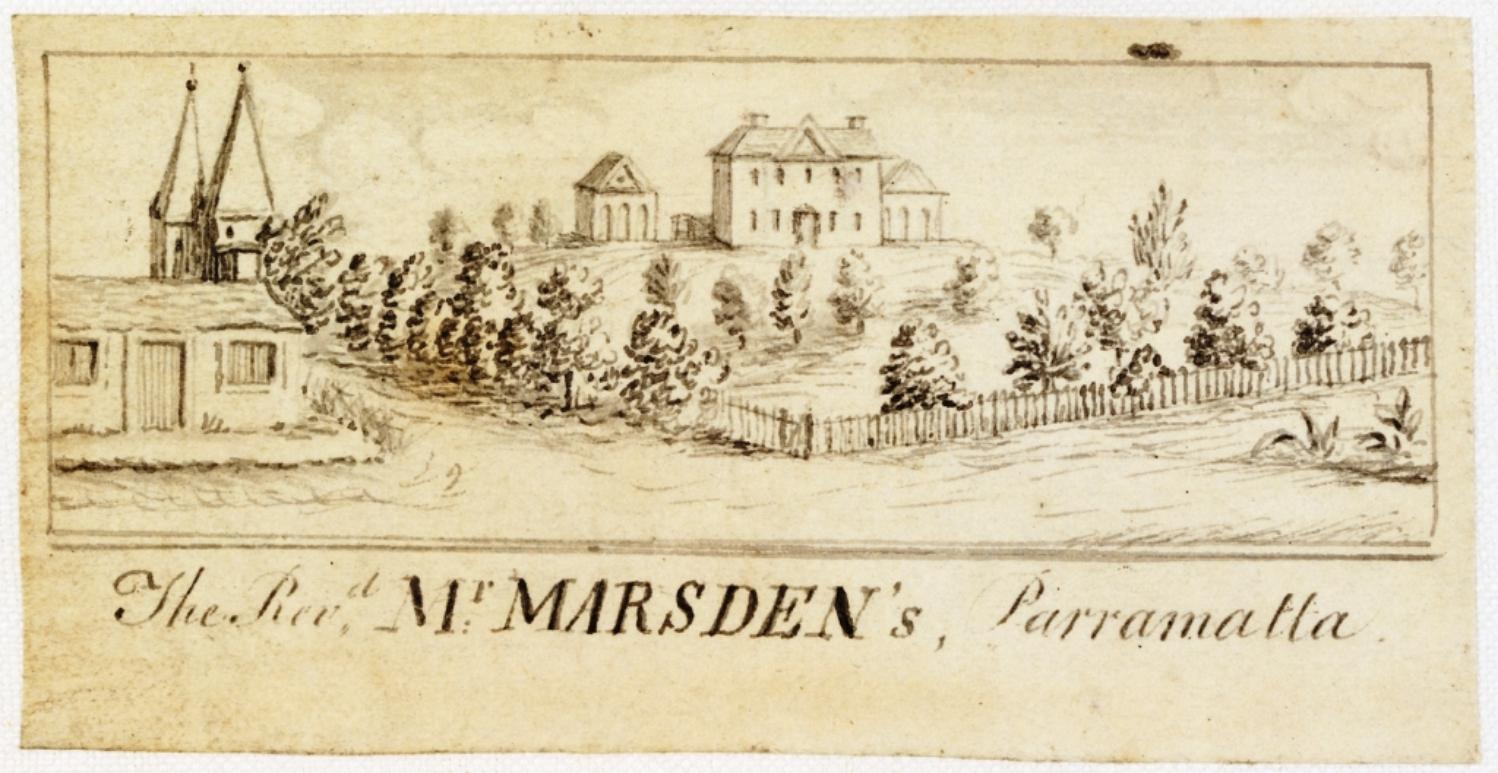
Reverend Mr. MARSDEN, J. P.
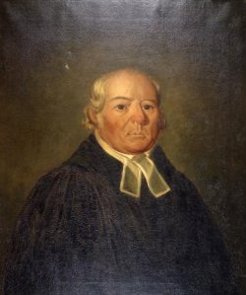 Samuel Marsden (1765-1838), chaplain, missionary and farmer, was born on 24 June 1765 at Farsley, Yorkshire, England, the son of Thomas Marsden, a blacksmith. He attended the village school, was then apprenticed to his father and grew up in an area and amongst a class much influenced by the Methodist religious revival. Well known locally as a lay preacher, Samuel gained the interest of the Elland Society, an Evangelical group within the Church of England which sponsored the education for the ministry of promising but ill connected youths. Aged about 24, he went to Hull Grammar School, where he met the Milners, members of the Clapham sect, and through them William Wilberforce, doyen of humanitarian and missionary projects, who was to influence decisively the course of Marsden's life.
Samuel Marsden (1765-1838), chaplain, missionary and farmer, was born on 24 June 1765 at Farsley, Yorkshire, England, the son of Thomas Marsden, a blacksmith. He attended the village school, was then apprenticed to his father and grew up in an area and amongst a class much influenced by the Methodist religious revival. Well known locally as a lay preacher, Samuel gained the interest of the Elland Society, an Evangelical group within the Church of England which sponsored the education for the ministry of promising but ill connected youths. Aged about 24, he went to Hull Grammar School, where he met the Milners, members of the Clapham sect, and through them William Wilberforce, doyen of humanitarian and missionary projects, who was to influence decisively the course of Marsden's life.
A proposal in March 1793 invited Elizabeth, daughter of Thomas Fristan of Hull, to take up the cross and share life's travails and pleasures with him across the seas. The couple were wed on 21 April; Samuel was ordained deacon on 17 March at Bristol and priest in May; on 1 July they left for New South Wales in the William. After a journey made memorable by Samuel's clashes with the captain and by the accouchement of Elizabeth as the ship was buffeted by a storm off Van Diemen's Land, they arrived in Sydney Cove on 10 March 1794.
In some significant ways the pattern of Marsden's life was set during his first year in New South Wales. As assistant to Rev. Richard Johnson, after a brief visit to Norfolk Island in 1795, he was stationed at Parramatta. It was an important centre in the colony and Marsden remained there after Johnson's departure, although for some years he was the only Anglican clergyman on the mainland. He was promised the position of senior chaplain in 1802, but was much vexed at receiving only part of its stipend, and was not formally promoted until after his return from England in 1810. Governor Lachlan Macquarie allowed him to live at Parramatta 'as being more convenient and centrical for the execution of his general superintending duties', and in September directed that Marsden should be regarded 'as the resident chaplain in that district'.
Marsden had quickly and deeply committed himself to farming, although he was inexperienced in it. By 1802 he had received 201 acres (81 ha) in grants, and had purchased 239 (97 ha) from other settlers; he had 200 acres (81 ha) cleared and grazed 480 sheep. Three years later he had over 1000 sheep, 44 cattle and 100 pigs on his farm which by then had increased to 1730 acres (700 ha) seven miles (11 km) from Parramatta. In 1798, with Surgeon Thomas Arndell, he had made a valuable report on the colony's agriculture; in 1803-05 he made several reports to Governor Philip Gidley King and to Sir Joseph Banks on the prospects of sheep-breeding and wool-growing. King thought Marsden 'the best practical farmer in the colony', and when he visited England on leave in February 1807 he was recommended by Governor William Bligh as one who had made the 'nature and soil' of the colony 'his particular study'. He concentrated on the development of strong heavy-framed sheep such as the Suffolk breed, which had a more immediate value in the colony than the fine-fleeced Spanish merinos imported by John Macarthur. In 1808 he had his own wool made up into a suit by the Thompsons of Horsforth in Yorkshire, and so impressed George III that he was given a present of merinos from the Windsor stud. Four years later more than 4000 lbs (1814 kg) of his wool was sold in England at 45d. a lb. Marsden was an important promoter of the wool staple, even though his contribution to technology, breeding and marketing was far eclipsed by that of Macarthur.
Samuel Marsden (1765-1838), by Joseph Backler, Alexander Turnbull Library, Wellington, National Library of New Zealand, ATL ref. G-620. A. T. Yarwood, 'Marsden, Samuel (1765–1838)', Australian Dictionary of Biography, National Centre of Biography, Australian National University, http://adb.anu.edu.au/biography/marsden-samuel-2433/text3237, published in hardcopy 1967
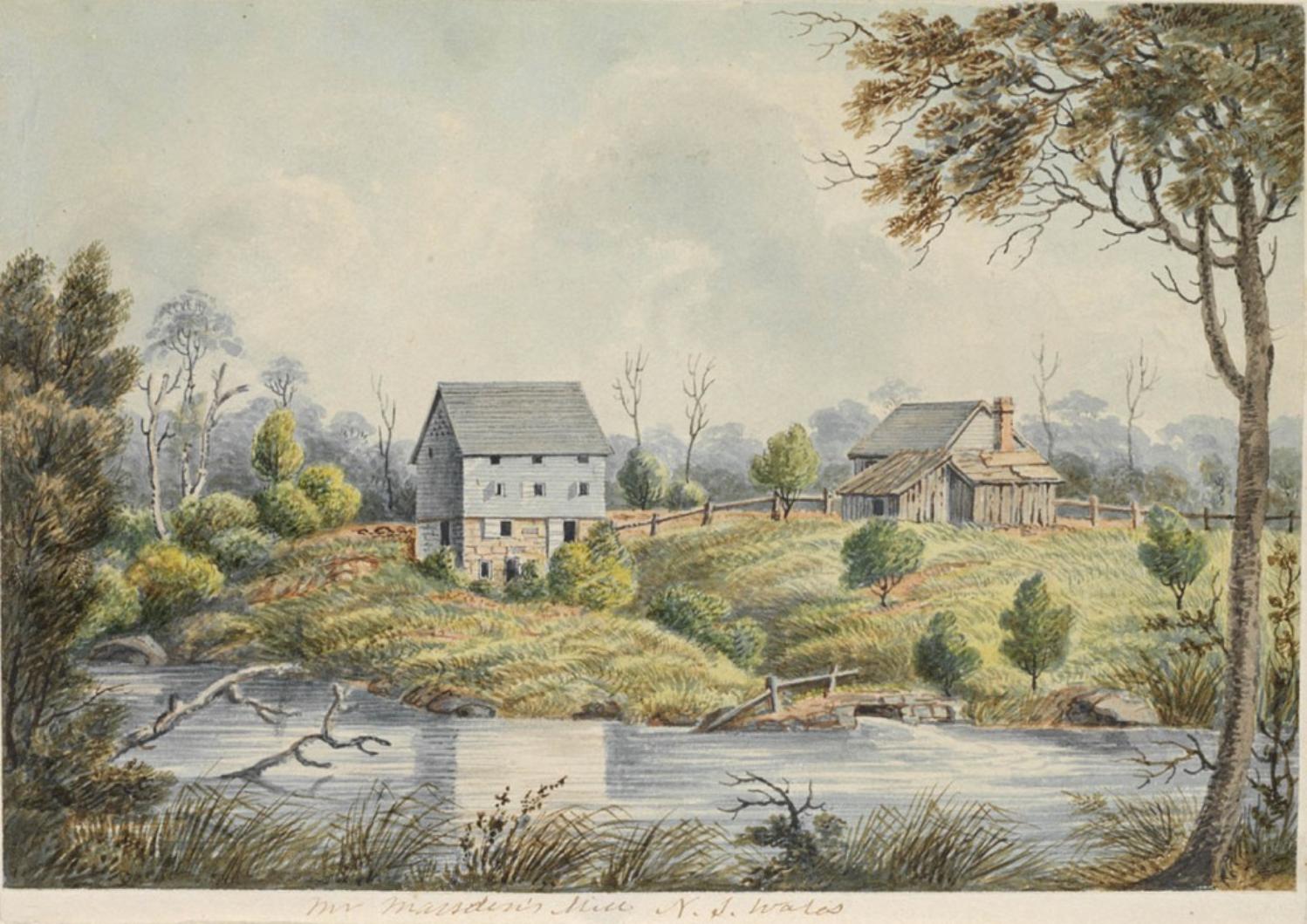
Mr Marsden's Mill N.S.Wales, near Parramatta, Imae. No.: a1120001, courtesy State Library of NSW.
J. T. CAMPBELL, Esquire, J. P;
John Thomas Campbell (1770?-1830), vice-regal secretary, was the eldest son of William Campbell, vicar of Newry, County Armagh, Ireland, and his wife Mary, née M'Cammon. Apparently Campbell and his brothers were educated at home by their father. Campbell's brother was curate at Caledon, County Tyrone, and Campbell himself seems to have enjoyed the patronage of the earl of Caledon, governor at the Cape, who recommended him to Macquarie when the latter called there in 1809. He joined the governor-designate's party, with an understanding that something would be done for him in New South Wales. Captain Henry Colden Antill noted that he 'had the appearance of being a gentlemanly well-informed man'. After they arrived in Sydney, on 1 January 1810 Macquarie appointed Campbell his secretary; Ellis Bent considered him 'very fit for the situation, which is very troublesome'. His salary was £282 10s., paid by the British government, to which Macquarie added £82 10s. from the colonial revenue as soon as authorized to do so in 1816. For eleven years he was Macquarie's chief assistant in the administration of the colony, his intimate friend and loyal supporter.
Campbell took a leading part in the founding of the Bank of New South Wales in 1816-17. As the first president of its board of directors he gave thorough attention daily to every detail of its organization and operations until it was well established. Although Macquarie, in his eagerness to present the bank's prospects in the best light, may have exaggerated the president's earlier experience as a banker, Campbell was obviously enthusiastic and competent.
Campbell was a large landholder and a most efficient farmer and breeder of cattle and horses. In 1811 Macquarie granted him 1550 acres (627 ha) at Bringelly, and later he received a grant near Rooty Hill, which to Marsden's indignation he named Mount Philo. He was also a large stock-holder in southern New South Wales. Reserved, frugal, and with a genuine dislike of ostentation, Campbell was not a popular politician, but his reputation for high principles and integrity was acknowledged by nearly all of his contemporaries. He reserved his strongest indignation for what he conceived to be hypocrisy and self-seeking, as in the case of his attacks on Marsden, Barron Field and his sycophants, and John Macarthur. As became a nephew of Samuel Johnson's 'Irish Dr Campbell', he had literary tastes, and his large collection of books was bequeathed to the Australian Subscription Library. Campbell died at Sydney on 7 January 1830.
R. F. Holder, 'Campbell, John Thomas (1770–1830)', Australian Dictionary of Biography, National Centre of Biography, Australian National University, http://adb.anu.edu.au/biography/campbell-john-thomas-1873/text2191, published in hardcopy 1966
MAJOR-GENERAL MACQUARIE, AND THE FIRST LANDING.-On Friday last JOHN THOMAS CAMPBELL, Esq. Provost Marshal for the Territory of New South Wales, upon the gratifying return of the day, gave a most superb Dinner to a large Party of the Officers (Civil, Military, and Naval) of the Colony, and other Gentlemen : His Honor Colonel ERSKINE (Lieutenant Governor), and Major GOULBURN (Colonial Secretary), were among the number of distinguished guests. A more splendid entertainment has not been given; and we somewhat regret that no faithful description of this development of princely liberality has not been handed to us. Affectionate remembrances, however, are not to pass altogether unheeded.
On Friday last an excellent Dinner was prepared at Hill's Tavern, Hyde Park, in commemoration of the First Landing in this Colony; as also, in honor of the Birthday of, our late worthy and respected Governor, Major General MACQUARIE. At half past 5 o'clock, a numerous and respectable body of the Inhabitants of Sydney, sat down to the sumptuous fare provided for the auspicious occasion; the arrangements of which did every credit to Mrs. Hill. SIMEON LORD, Esq. was in the chair. After the cloth became removed, several loyal and appropriate toasts were drank, amongst which, the Chairman gave the following:-"THE KING !" "THE ROYAL FAMILY OF GREAT BRITAIN !""Our worthy Governor, Sir THOMAS BRISBANE !" “Major General MACQUARIE-our late worthy GOVERNOR !" "The LIEUTENANT GOVERNOR !" " LADY BRISBANE, and the LADIES of the COLONY !" "Success to the Agricultural, Commercial, and Manufacturing Interests of the Colony !" The evening was spent in much harmony and conviviality, and with all that urbanity and good humour so desirable in such assemblies.
Mr. Samuel Terry, of Pitt-street, upon the same occasion, also gave a Dinner, no way inferior to the above, to a select party. The donor of this feast manifested that he could deal well a liberal hand, for the festive board actually groaned under its ponderous weight of true British hospitality. We understand that Dinners were given at several of the Taverns in the interior, in honor of the day.
On Thursday last the Agricultural Society held the General Quarterly Meeting at Nash's Inn, Parramatta, and afterwards dined together. Mr. Nash provided an excellent Dinner, at a very moderate charge ; and the desert was contributed from the gardens of Dr. Townson and Captain Piper. It consisted of no fewer than 18 kinds of fresh fruit, and 4 of dried; among which were the banana, the Orlean plum, the green gage, the real peach, the cathead apple, and a peculiarly fine sort of musk melon. We understand that the Meetings are to be held at Walker's, and Nash's alternately. A Horticultural Subscription, of 8 dollars, is set on foot, and a Committee chosen. The future Agricultural Subscription was altered to 20 dollars.-At this Meeting three new Members were selected, and twelve proposed for the next Meeting.
Mr Jonas Bradley, to whom the silver tankard was voted for his specimen of tobacco, laid before the Society a statement of his mode and cure, a copy of which we are promised for publication. The President presented him with the piece of plate, suitably inscribed (the workmanship by Mr. Robertson), and informed him, with a view to encourage the colonial growth of tobacco, the legislature had now authorized the Governor, at discretion, to lay a duty of 4 shillings per lb. upon the importation of foreign tobacco. This meritorious marine settler acquainted the Society that, although Governor MACQUARIE had never given him more than 50 acres of land, yet he had acquired up-wards of 100 head of cattle and 800 sheep. One of his sons was among the number of proposed new Members.
Sunday ae'nnight being the 36th Anniversary of the First Landing in Australasia, the Royal Standard was displayed upon the heights of Fort* Philip throughout the whole of the day. MAGISTRATE FOR THE WEEK—RICHARD BROOKS, Esq. (1823, February 6 - Thursday). The Sydney Gazette and New South Wales Advertiser (NSW : 1803 - 1842), p. 2. Retrieved from http://nla.gov.au/nla.news-article2181620
EDWARD WOLLSTONECRAFT, Esquire, J. P;
Edward Wollstonecraft (1783-1832), merchant and landowner, was the son of Edward Wollstonecraft, a London solicitor, who was a brother of Mary Wollstonecraft Godwin. Edward and his sister Elizabeth were therefore cousins of the ill-fated Fanny Imlay and of Mary Godwin who became the second wife of Shelley and was the author of Frankenstein. His parents died when relatively young. Wollstonecraft resented the notoriety of his aunt and sought escape and fortune for himself and his sister in travel and trade.
Wollstonecraft arrived in Sydney in September 1819 in the Canada. Wollstonecraft was permitted to locate some 500 (202 ha) of his 2000 acres (809 ha) on the north side of Sydney Harbour, and his tenure was made official in June 1825. In spite of ill health he became a magistrate and a central figure in the Sydney commerce of the 1820s. As a director of the Bank of New South Wales and of the Bank of Australia, and as chairman of the Chamber of Commerce, he appears to have been chiefly concerned with maintaining the general financial liquidity of the colony's economy. He argued that the introduction of the Spanish dollar had depreciated colonial values and embarrassed external trade, and he urged the government to make loans to the colonial banks in the financial crises of 1826 and 1828.
A wide variety of merchandise passed through the warehouse of Berry and Wollstonecraft in George Street. In 1820, while Berry was still in London, Wollstonecraft advised him to concentrate on obtaining the solid necessities of a young colony and to beware of fripperies 'and the other female trash by which we are likely to lose so much already'.
Berry returned to Sydney in 1821, chartering the Royal George and bringing with him Governor Sir Thomas Brisbane and his party as passengers. With Wollstonecraft he successfully applied for a further 10,000 acres (4047 ha) on their undertaking to maintain 100 convicts. The grant was taken on the Shoalhaven River on the initiative of Berry, who explored the area, liked it and assured it of safe access from the sea by cutting a canal between the Crookhaven and Shoalhaven Rivers. On this foundation Wollstonecraft's relentless business energy worked, for he believed that the colony's greatest economic need was a reliable export staple. Finding the Shoalhaven region climatically unsuited for sheep, his long term plan at Coolangatta (Cullingatta and Coolungatta), as the property came to be called, was to clear the hillsides and drain the swamps for agriculture. Meanwhile the forests of cedar and blue gum could be put to use. Teams of sawyers, both assigned convicts and freemen, were organized, and by July 1823 thirty-six men were employed in getting and preparing timber for which Wollstonecraft was assiduous in seeking markets. The bulk of it was exported and thus provided a desirable balance to the imports demanded by the diverse trade still carried on by the partners in Sydney. While timber proved an immediate and sure source of wealth, experiments were made at Shoalhaven with other crops of similar economic potential, the chief being tobacco which was normally retailed at enormous profit to the importer. The partners generally arranged that one was at Shoalhaven and the other at the North Shore. The bond between them was strengthened by Berry's marriage in September 1827 to Elizabeth, Wollstonecraft's sister.
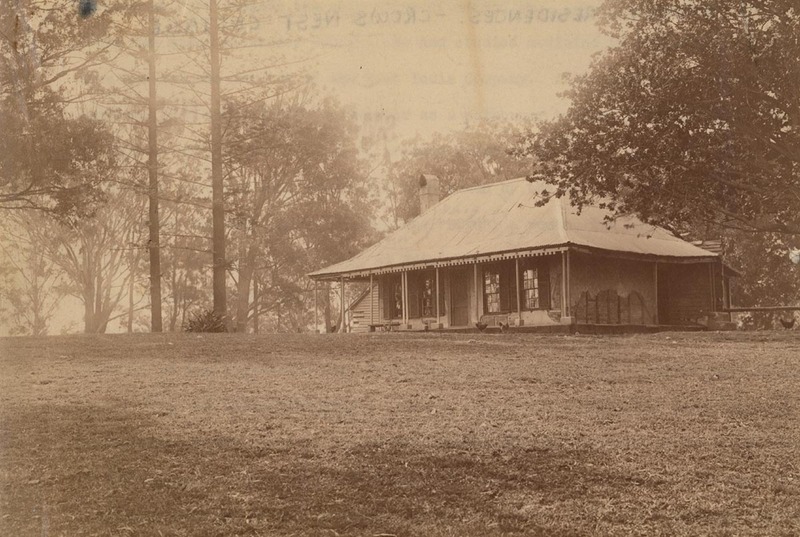
Both Wollstonecraft and Berry had the eighteenth-century Englishman's view of the social importance of land, and they saw at Shoalhaven the beginning of a great estate over which eventually they might rule as patriarchs. In pursuit of their object Wollstonecraft was almost morbidly jealous of encroaching settlers. His aim was to exclude them altogether or, failing that, so to encircle their holdings as to make them unworkable. This the partners were increasingly able to do, both by manipulating the location of their own grants before survey, and by buying the promises of grants from other settlers and locating them as strategy required.
Wollstonecraft died on 7 December 1832. His life in Australia depended largely on Berry's enterprise, yet Berry could rightly claim that he had 'a naturally defective temper', and that his conduct in his last years was 'such as to render my existence hardly tolerable'. His letters leave an impression of sardonic bitterness which may, however, have been the product of ill health. His business acumen and integrity were beyond question, yet it is doubtful that they would have found any important employment without the wider vision and more civilized instincts of Berry.
Wollstonecraft never married. A suburb of Sydney was named after him and another after his cottage, Crow's Nest, on the North Shore. In March 1846 his remains were removed from the Sydney burial ground and placed with those of his sister, who died on 11 April 1845, in a magnificent tomb erected by Berry in the cemetery near St Thomas's Church of England, North Sydney.
M. D. Stephen, 'Wollstonecraft, Edward (1783–1832)', Australian Dictionary of Biography, National Centre of Biography, Australian National University, http://adb.anu.edu.au/biography/wollstonecraft-edward-2812/text4025, published in hardcopy 1967
Crows Nest Cottage Date of Work undated [ca. 1880-1890s] Image No.: a089387 courtesy State Library of NSW
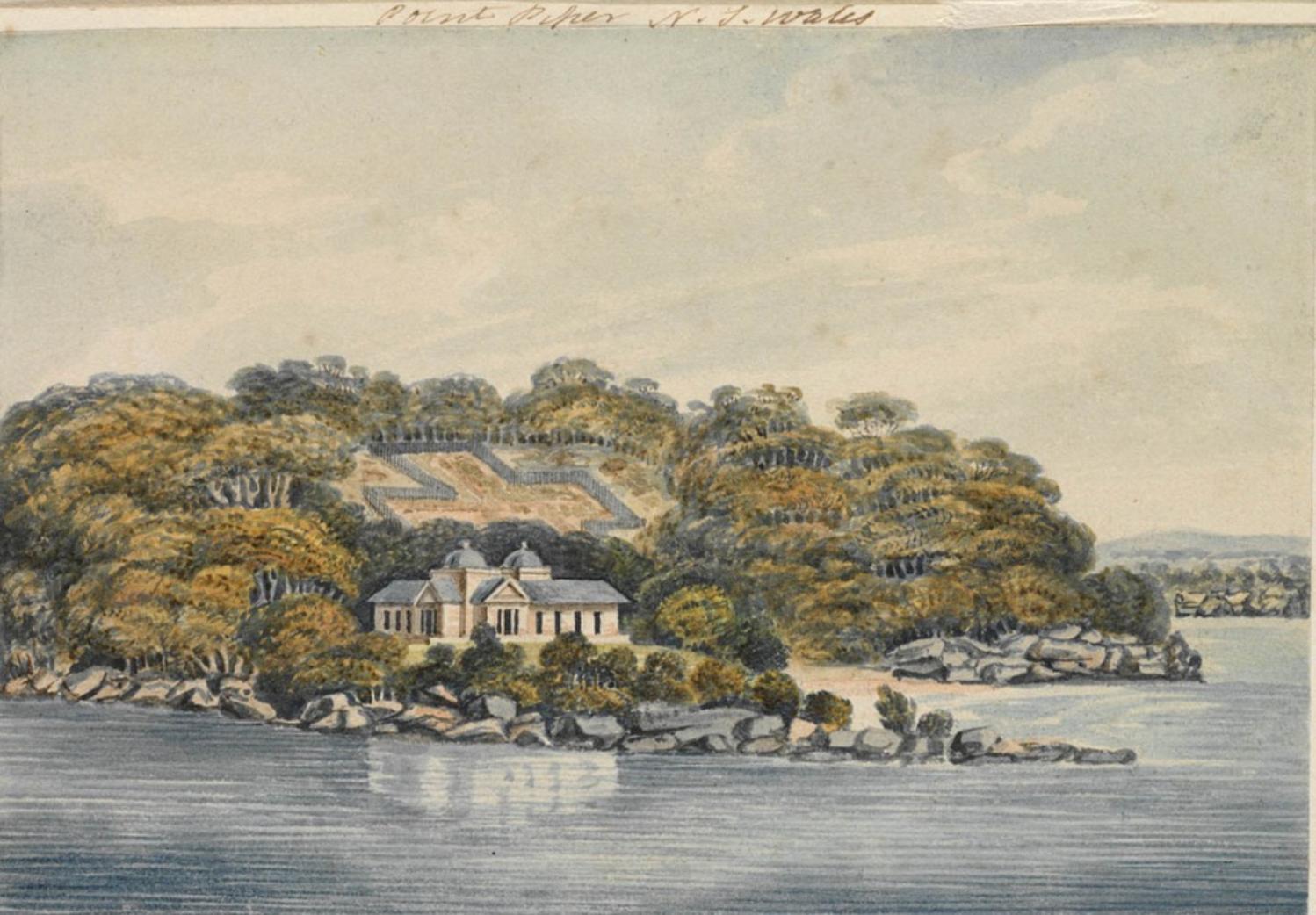
Eliza Point, near Sydney New South WalesDigital Order Number: a1120004, courtesy State Library of NSW
JOHN PIPER, Esquire, J. P
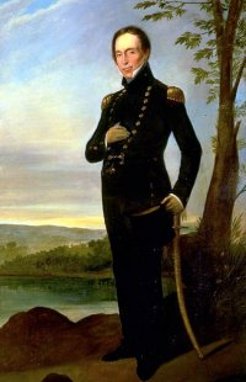 John Piper (1773-1851), military officer, public servant and landowner, was born on 20 April 1773 at Maybole, Ayrshire, Scotland, the son of Hugh Piper, a doctor. The Pipers were in the main an army family, and Scots only by adoption, having come from Cornwall and before that from Germany. Through the influence of his uncle, Captain John Piper, young John received a commission as ensign in the newly formed New South Wales Corps in April 1791, as his younger brother Hugh was to do in 1799.
John Piper (1773-1851), military officer, public servant and landowner, was born on 20 April 1773 at Maybole, Ayrshire, Scotland, the son of Hugh Piper, a doctor. The Pipers were in the main an army family, and Scots only by adoption, having come from Cornwall and before that from Germany. Through the influence of his uncle, Captain John Piper, young John received a commission as ensign in the newly formed New South Wales Corps in April 1791, as his younger brother Hugh was to do in 1799.
John sailed in the Pitt and arrived in Sydney in February 1792 when the infant settlement was still fighting for its life in the face of starvation. Piper was an immediate social success and became a close family friend of John Macarthur.
John resigned his commission and decided to seek civilian employment in the colony. In 1813 he was appointed Naval Officer in Sydney and arrived back in February 1814. On 10 February 1816 he married Mary Ann, by special licence. She had borne him two more sons while they were away and in due course they had nine more.
His duties included the collection of customs duties, excise on spirits and harbour dues, control of lighthouses and work which is now the province of the water police. The post was very much to Piper's taste and proved very remunerative: with a percentage on all monies collected, his income from it rose to more than £4000 a year. He bought the property now known as Vaucluse House.
In 1816 he was granted 190 acres (77 ha) of land on Eliza Point, now Point Piper, for the site of his official residence. Here he built Henrietta Villa (also called the Naval Pavilion) at the cost of £10,000 and furnished it in the most luxurious style.
It was completed in 1822 and became the scene of many sumptuous entertainments.
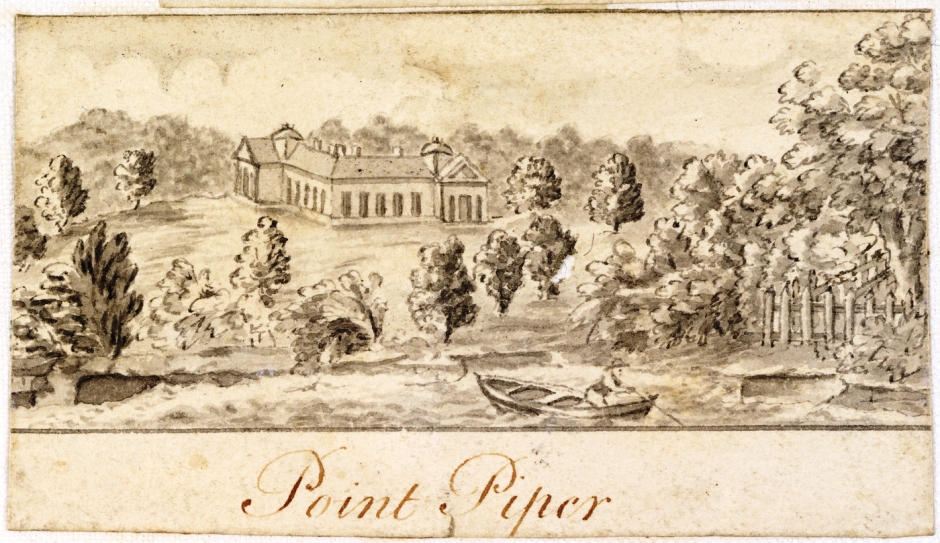
Point Piper Image No: 1080063h, courtesy State Library of NSW
Piper was a close friend of Governor Lachlan Macquarie, who in 1819 made him a magistrate. In 1825 he was chairman of directors of the Bank of New South Wales. He sat on the local committee of the Australian Agricultural Co., was president of the Scots Church committee and took part in many social and sporting activities. He owned much property, acquired by grant or purchase. Besides Point Piper he had 475 acres (192 ha) at Vaucluse, 1130 (457 ha) at Woollahra and Rose Bay, a farm of 295 acres (119 ha) at Petersham, 700 (283 ha) at Neutral Bay, 80 (32 ha) at Botany Bay, 2000 (809 ha) at Bathurst, 300 (121 ha) in Van Diemen's Land with various smaller farms, and an acre (0.4 ha) of city land in George Street. He was, however, not as solvent as he appeared and in 1826 he raised a mortgage of £20,000.
John Piper was a man of his times. He personified the colonial dream. In his sixty years in the colony he adapted himself to its development. During the military regime he was an officer; when Macquarie created a civil state he became a civil servant; when the race was to the pioneer he became one. He was honourable, generous, gay and so well loved that he was forgiven things which would have wrecked a stronger man. He was no business man, completely lacking the shrewdness which enriched so many of his brother officers.
John Piper (1773-1851), by Augustus Earle State Library of New South Wales, Original : ML 6
Marjorie Barnard, 'Piper, John (1773–1851)', Australian Dictionary of Biography, National Centre of Biography, Australian National University, http://adb.anu.edu.au/biography/piper-john-2552/text3449, published in hardcopy 1967
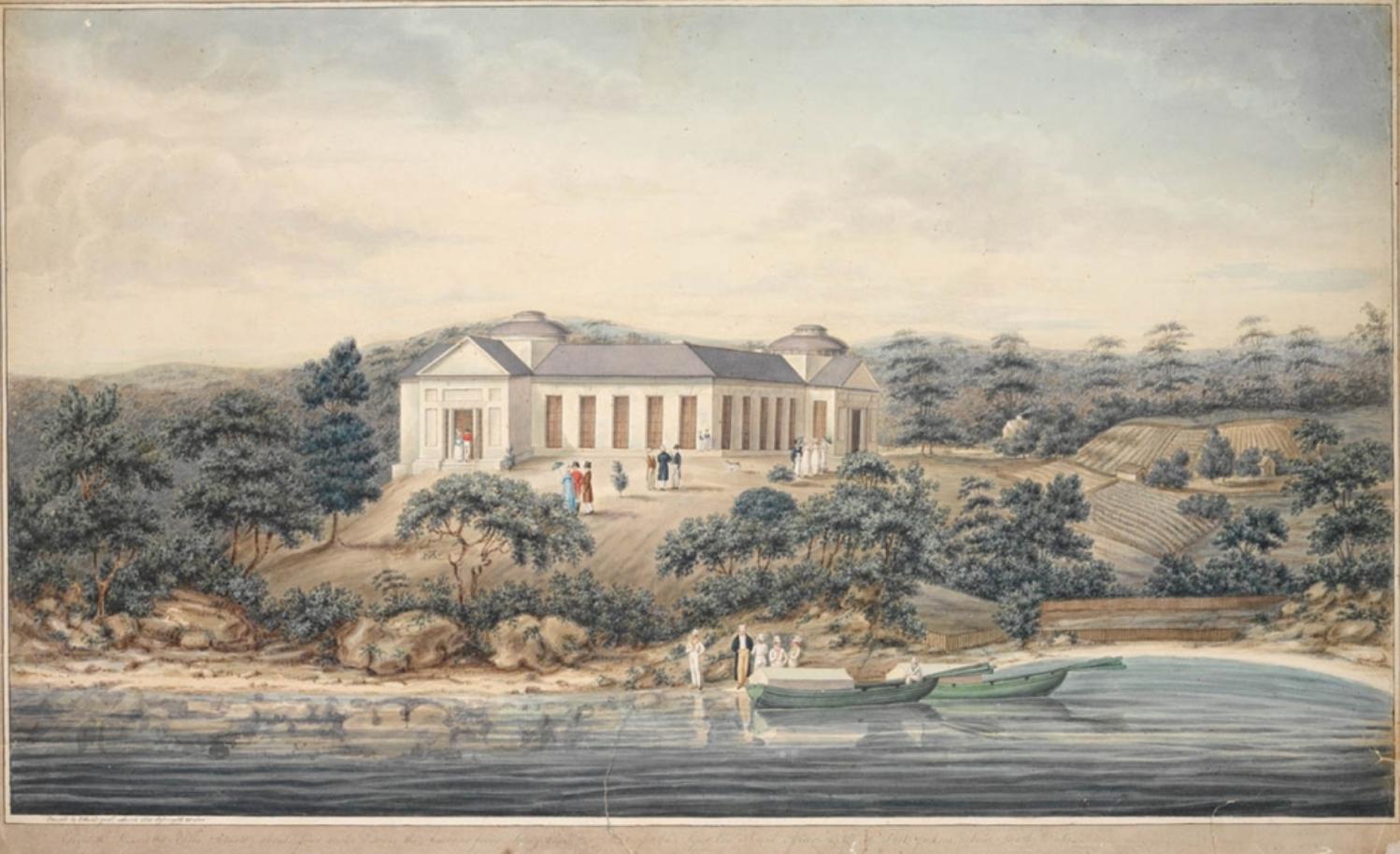
Henrietta Villa, built between 1816 and 1822, was the property of Captain Piper and most likely designed by Henry Kitchen. The house was named after Mrs Macquarie and became a symbol of progress in the colony. When this drawing was executed, the building was not finished as the verandah covering the long windows are absent. -- Reference: The Artist and the patron : aspects of colonial art in New South Wales / [compiled by] Patricia R. McDonald and Barry Pearce. [Sydney] : Art Gallery of New South Wales, 1988.
Signed and dated at lower left in black ink, "Painted by R. Read junr. March 1820 Sydney N.S. Wales".
Inscribed, probably in the artist's hand, beneath frame lines in pencil "Elizabeth Heneretta [i.e. Henrietta] Villa situate about four miles Down the Harbour from Sydney Cove the seat of John Piper Esqr. Naval Officer etc. etc. of Port Jackson New South Wales". Image No: a128862, courtesy State Library of NSW.
WILLIAM Cox, Esq. J. P.
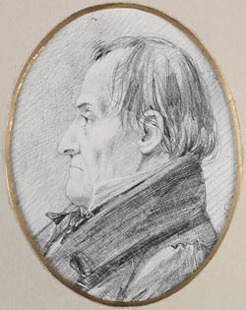 William Cox (1764-1837), military officer, roadmaker and builder, was born at Wimborne, Dorset, England, and educated at the local grammar school. He later moved to Devizes, Wiltshire, where he married Rebecca Upjohn of Bristol. He joined the army in 1797 and was commissioned a lieutenant in the New South Wales Corps; next year he was appointed paymaster. In 1799, accompanied by his wife and four of his six small sons, he sailed for New South Wales in the Minerva by way of Cork, where the ship picked up a consignment of Irish convicts who had taken part in the rebellion the previous year. Soon after he arrived in the colony on 11 January 1800, Cox acquired Brush Farm at Dundas from John Macarthur whom he had succeeded as paymaster, several adjoining farms and much stock. He overstrained his credit and in 1803 facing a deficiency of £7900 in his regimental accounts he was suspended from office. The sum of £2000 was secured, and to pay the remainder his estate was assigned to trustees and sold for the benefit of his creditors, including the army agents. By 1806 they had been paid in full, but by then Cox had been ordered to England under arrest 'to answer such charges as may be brought against him'. He sailed in February 1807 but appears never to have been brought to trial. In 1809 he resigned his commission and devoted the rest of his life to civilian pursuits. Through this enforced absence he was away from the colony during the William Bligh rebellion, and was never called upon to reveal where his sympathies lay; however, his wife and son signed an address of loyalty to Bligh organized by the settlers on the Hawkesbury, where Cox had gone to live after the sale of Brush Farm, and during the King period had been strongly criticized by Macarthur and the corps. Cox received the first grant of land west of the mountains, 2000 acres (809 ha) across the river from Bathurst which he called Hereford. Although neither he nor his sons made it their home, they ran sheep there for some time. About 1810 they had taken up land in the Mulgoa valley where three of his sons lived for many years. Later in the Mudgee district his sons and grandsons formed studs from William's flocks which became famous for the fine quality of their wool. His large estate at Clarendon near Windsor had all the appearance of a self-contained village. Over fifty convict servants acted as smiths, tanners, harness makers, wool sorters, weavers, butchers, tailors and herdsmen. Cox had steadily improved his flocks, which Commissioner Bigge described in 1820 as among the six best in the colony. He explored the source of the Lachlan River and organized provisions for John Oxley's expedition. He was the first president of the Windsor Benevolent Society, chairman of the local Macquarie Memorial fund, and a vice-president of the Agricultural Society. Politically he was always a radical, signing many petitions for such reforms as representative government, repeal of taxes, and trial by jury, being 'firmly of the opinion' that 'Respectable Emancipists' would be worthy jurors. In 1824 Brisbane submitted his name for the proposed new Legislative Council, but he was not appointed. He died on 15 March 1837, and was buried, with his first wife, at St Matthew's, Windsor. A window to his memory was erected in St Andrew's Cathedral by the sons of his first marriage.
William Cox (1764-1837), military officer, roadmaker and builder, was born at Wimborne, Dorset, England, and educated at the local grammar school. He later moved to Devizes, Wiltshire, where he married Rebecca Upjohn of Bristol. He joined the army in 1797 and was commissioned a lieutenant in the New South Wales Corps; next year he was appointed paymaster. In 1799, accompanied by his wife and four of his six small sons, he sailed for New South Wales in the Minerva by way of Cork, where the ship picked up a consignment of Irish convicts who had taken part in the rebellion the previous year. Soon after he arrived in the colony on 11 January 1800, Cox acquired Brush Farm at Dundas from John Macarthur whom he had succeeded as paymaster, several adjoining farms and much stock. He overstrained his credit and in 1803 facing a deficiency of £7900 in his regimental accounts he was suspended from office. The sum of £2000 was secured, and to pay the remainder his estate was assigned to trustees and sold for the benefit of his creditors, including the army agents. By 1806 they had been paid in full, but by then Cox had been ordered to England under arrest 'to answer such charges as may be brought against him'. He sailed in February 1807 but appears never to have been brought to trial. In 1809 he resigned his commission and devoted the rest of his life to civilian pursuits. Through this enforced absence he was away from the colony during the William Bligh rebellion, and was never called upon to reveal where his sympathies lay; however, his wife and son signed an address of loyalty to Bligh organized by the settlers on the Hawkesbury, where Cox had gone to live after the sale of Brush Farm, and during the King period had been strongly criticized by Macarthur and the corps. Cox received the first grant of land west of the mountains, 2000 acres (809 ha) across the river from Bathurst which he called Hereford. Although neither he nor his sons made it their home, they ran sheep there for some time. About 1810 they had taken up land in the Mulgoa valley where three of his sons lived for many years. Later in the Mudgee district his sons and grandsons formed studs from William's flocks which became famous for the fine quality of their wool. His large estate at Clarendon near Windsor had all the appearance of a self-contained village. Over fifty convict servants acted as smiths, tanners, harness makers, wool sorters, weavers, butchers, tailors and herdsmen. Cox had steadily improved his flocks, which Commissioner Bigge described in 1820 as among the six best in the colony. He explored the source of the Lachlan River and organized provisions for John Oxley's expedition. He was the first president of the Windsor Benevolent Society, chairman of the local Macquarie Memorial fund, and a vice-president of the Agricultural Society. Politically he was always a radical, signing many petitions for such reforms as representative government, repeal of taxes, and trial by jury, being 'firmly of the opinion' that 'Respectable Emancipists' would be worthy jurors. In 1824 Brisbane submitted his name for the proposed new Legislative Council, but he was not appointed. He died on 15 March 1837, and was buried, with his first wife, at St Matthew's, Windsor. A window to his memory was erected in St Andrew's Cathedral by the sons of his first marriage.
William Cox (1764-1837), by Charles Rodius, State Library of New South Wales, Original : ML 1379
Edna Hickson, 'Cox, William (1764–1837)', Australian Dictionary of Biography, National Centre of Biography, Australian National University, http://adb.anu.edu.au/biography/cox-william-1934/text2309, published in hardcopy 1966
Dr. TOWNSON, L. L. D.
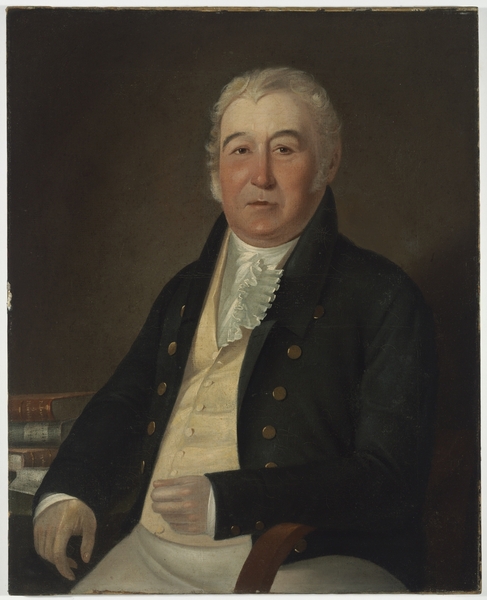 Robert Townson (1762?-1827), scholar, scientist and settler, was probably baptized on 4 April 1762 at Richmond, Surrey, England, son of John Townson, merchant. Robert's zest for natural history dictated his activities for many years. He travelled widely as a gentleman scholar, collaborating with the professors at the universities he visited. In 1791 he was elected a fellow of the Royal Society of Edinburgh. He then visited the Universities of Copenhagen and Uppsala. After contributing a paper to the Linnean Society of London in 1792 on 'The Perceptivity of Plants', he made his headquarters at Göttingen University.
Robert Townson (1762?-1827), scholar, scientist and settler, was probably baptized on 4 April 1762 at Richmond, Surrey, England, son of John Townson, merchant. Robert's zest for natural history dictated his activities for many years. He travelled widely as a gentleman scholar, collaborating with the professors at the universities he visited. In 1791 he was elected a fellow of the Royal Society of Edinburgh. He then visited the Universities of Copenhagen and Uppsala. After contributing a paper to the Linnean Society of London in 1792 on 'The Perceptivity of Plants', he made his headquarters at Göttingen University.
After plans for the study of mineralogy and geology in India fell through, Townson's thoughts turned to Australia. He was often at the home of Sir Joseph Banks and had there met William Paterson of the New South Wales Corps. His brother, Captain John Townson, also returned to England in 1800, so he had ample opportunities to learn about the new settlement. When John decided to return as a settler, Robert approached the British government. He was warmly received, informed that he was the type most urgently needed in the colony, promised land and indulgences, and allowed £100 to buy books and a laboratory for the colony. DrTownson arrived in Sydney in the Young William on 7 July 1807. Proficient in all branches of natural science and also in Latin, Greek, German, French, he was the most eminent scholar in the young colony.
Governor Lachlan Macquarie in 1811 he granted him 1680 acres (680 ha) at Botany and added 1000 acres (405 ha) near the present Minto. This became the famous Varro Ville farm, but since these grants were made on the customary condition that the land be cultivated and not sold for five years, Townson again felt aggrieved. He had been living on his capital for nearly four years and was afraid of penury. He sought permission to sell his land and return to England. In the end he remained but developed a psychopathic personality. He subordinated everything to the development of his farms, shut himself off from society, and apparently did no scientific work in New South Wales. He became 'singular' and eccentric, and his rigid economy became a byword. He also nursed undue hostility towards all who had contributed to his critical situation; Macquarie described him as 'discontented' and one of his leading opponents, though there is no evidence that Townson took part in intrigues against him.
After Macquarie departed Townson began to take his rightful place in the community. In 1822 he became a foundation vice-president of the Agricultural Society and a member of its Horticultural and Stock Fund Committees; Edward Wollstonecraft proposed him for membership of the Philosophical Society of Australasia in the same year, and though the society's records do not disclose whether or not he was elected, it is probable that he was. In 1822 he joined in the protest against the commissariat paying for purchases in dollars, and in 1824 in the memorials against the British duties on wool. In 1826 he was appointed a magistrate. His name appeared regularly on subscription lists, and headed the list of donations towards establishing the Sydney Dispensary to give free medical attention to the poor. His invitations to dinner called for an early arrival so that there could be at least two hours of conversation before the meal. The contents of his library offered for sale after his death reveal his wide interests. Varro Ville became a show place for its beauty, abundance and variety in orchard and garden; his vineyard was second only to that of Gregory Blaxland; his fine-woolled sheep and their clip were in great demand; his cattle were numerous and in the opinion of his contemporaries 'no single man had accomplished more in the rearing of stock'.
V. W. E. Goodin, 'Townson, Robert (1762–1827)', Australian Dictionary of Biography, National Centre of Biography, Australian National University, http://adb.anu.edu.au/biography/townson-robert-2743/text3879. Doctor Robert Townson / painted by Augustus Earle painted between 1825-1827, Image No.: a3540001, courtesy State Library of NSW.
JOHN BLAXLAND, Esquire, JP
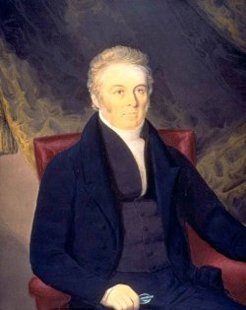 John Blaxland (1769-1845), landowner and merchant, was born on 4 January 1769, the eldest son of John Blaxland and Mary, née Parker, of Fordwich, Kent, England. After education at The King's School, Canterbury, he entered the army, rising to the rank of captain in the Duke of York's Cavalry. He resigned his commission in 1792 and lived at Newington, Kent, where he managed the family estates. Blaxland decided to emigrate because his farm resources, even when swollen by wartime prices, were inadequate for his pretensions. Moreover he became depressed at England's 'gloomy prospects'. New South Wales was fixed upon by John and his younger brother Gregory as a result of the persuasions of Sir Joseph Banks and the indulgences promised them by the Colonial Office. John agreed to invest £6000 in the colony, in return for a free passage for his family and servants, free freight for his stores and equipment, a land grant of 8000 acres (3237 ha), and eighty convicts, to be clothed and fed for eighteen months by the government. Castlereagh, writing to Governor Philip Gidley King, stressed the 'property and Education' of the Blaxlands, who could be expected to 'set useful Examples of Industry and Cultivation … and … be fit persons to whose Authority the Convicts may be properly entrusted'.
John Blaxland (1769-1845), landowner and merchant, was born on 4 January 1769, the eldest son of John Blaxland and Mary, née Parker, of Fordwich, Kent, England. After education at The King's School, Canterbury, he entered the army, rising to the rank of captain in the Duke of York's Cavalry. He resigned his commission in 1792 and lived at Newington, Kent, where he managed the family estates. Blaxland decided to emigrate because his farm resources, even when swollen by wartime prices, were inadequate for his pretensions. Moreover he became depressed at England's 'gloomy prospects'. New South Wales was fixed upon by John and his younger brother Gregory as a result of the persuasions of Sir Joseph Banks and the indulgences promised them by the Colonial Office. John agreed to invest £6000 in the colony, in return for a free passage for his family and servants, free freight for his stores and equipment, a land grant of 8000 acres (3237 ha), and eighty convicts, to be clothed and fed for eighteen months by the government. Castlereagh, writing to Governor Philip Gidley King, stressed the 'property and Education' of the Blaxlands, who could be expected to 'set useful Examples of Industry and Cultivation … and … be fit persons to whose Authority the Convicts may be properly entrusted'.
Although the British government, by sponsoring the Blaxlands, had taken a step which directly fostered private enterprise, there was no attempt to alter the colonial judicial and administrative structures to encompass a broadening of economic activity. Thus when John arrived in the colony in April 1807, he found that his capital and proposed activities were regarded with suspicion by officer-entrepreneurs of the colonial government and the New South Wales Corps. His first mistake in the eyes of the government was to ignore crop cultivation, and, in partnership with Gregory, to concentrate on the cattle industry: breeding, slaughtering, salting down (for which he produced the first suitable colonial salt), and selling meat and dairy produce. His other ventures, which Governor William Bligh disparaged as 'speculative' and 'mercantile', included sealing with the ship Brothers, of which he was part-owner with a London firm. He earned the disfavour of the commercial community as well as of the governor by his association with the former convict, Simeon Lord, but his crowning indiscretion was, after applying for a distilling licence, to offer Bligh a share in the company. Accordingly, Bligh was indifferent to Blaxland's complaints that he had received only 1290 acres (522 ha) on the Parramatta River, called Newington, and a third of the convicts due to him.
John Blaxland (1769-1845), by Richard Read State Library of New South Wales, Original : ML 308
T. H. Irving, 'Blaxland, John (1769–1845)', Australian Dictionary of Biography, National Centre of Biography, Australian National University, http://adb.anu.edu.au/biography/blaxland-john-1796/text2033, published in hardcopy 1966
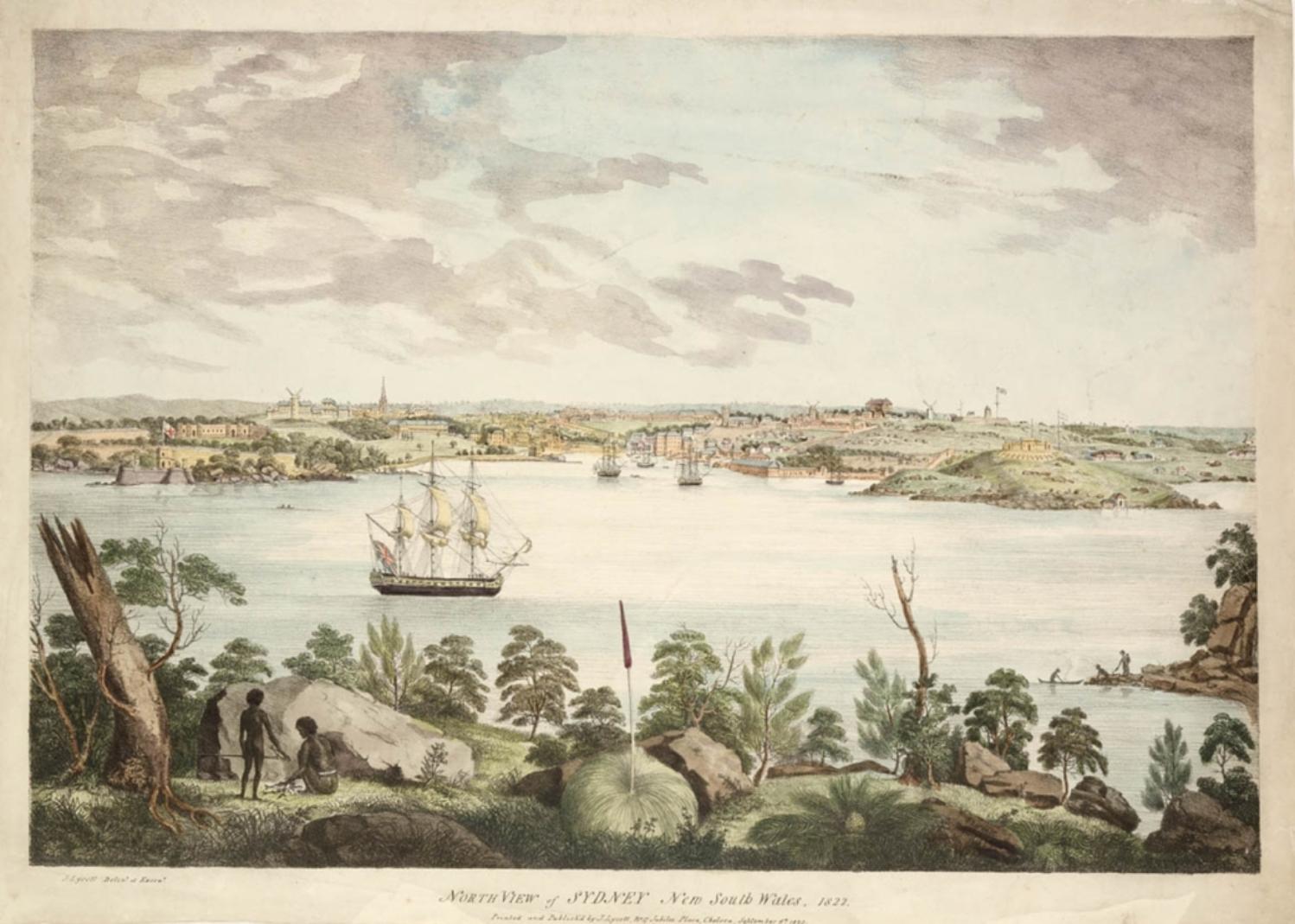
North View of Sydney New South Wales taken from the North Shore. 1822 by Joseph Lycett, ca. 1775-1828. Image No.: a128797, courtesy State Library of NSW
The Royal Easter Show Began As the Royal Agricultural Society of New South Wales - threads collected and collated by A J Guesdon, 2014.